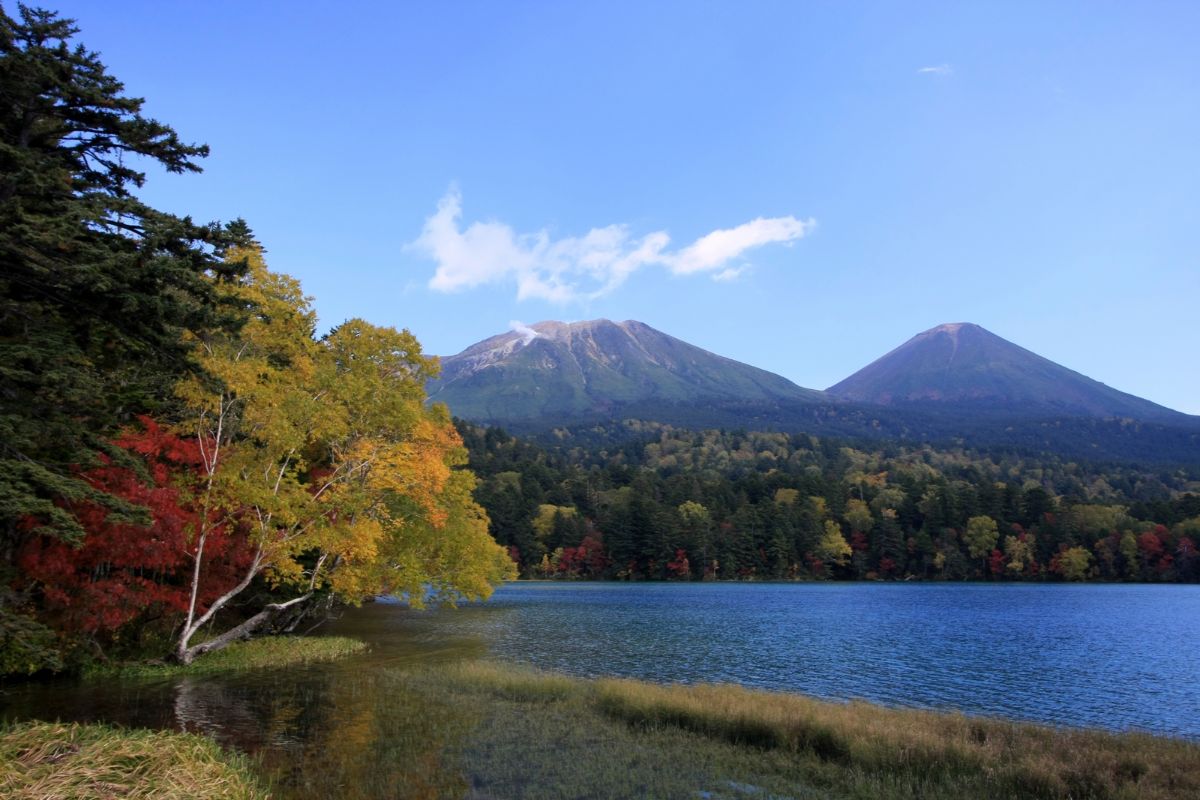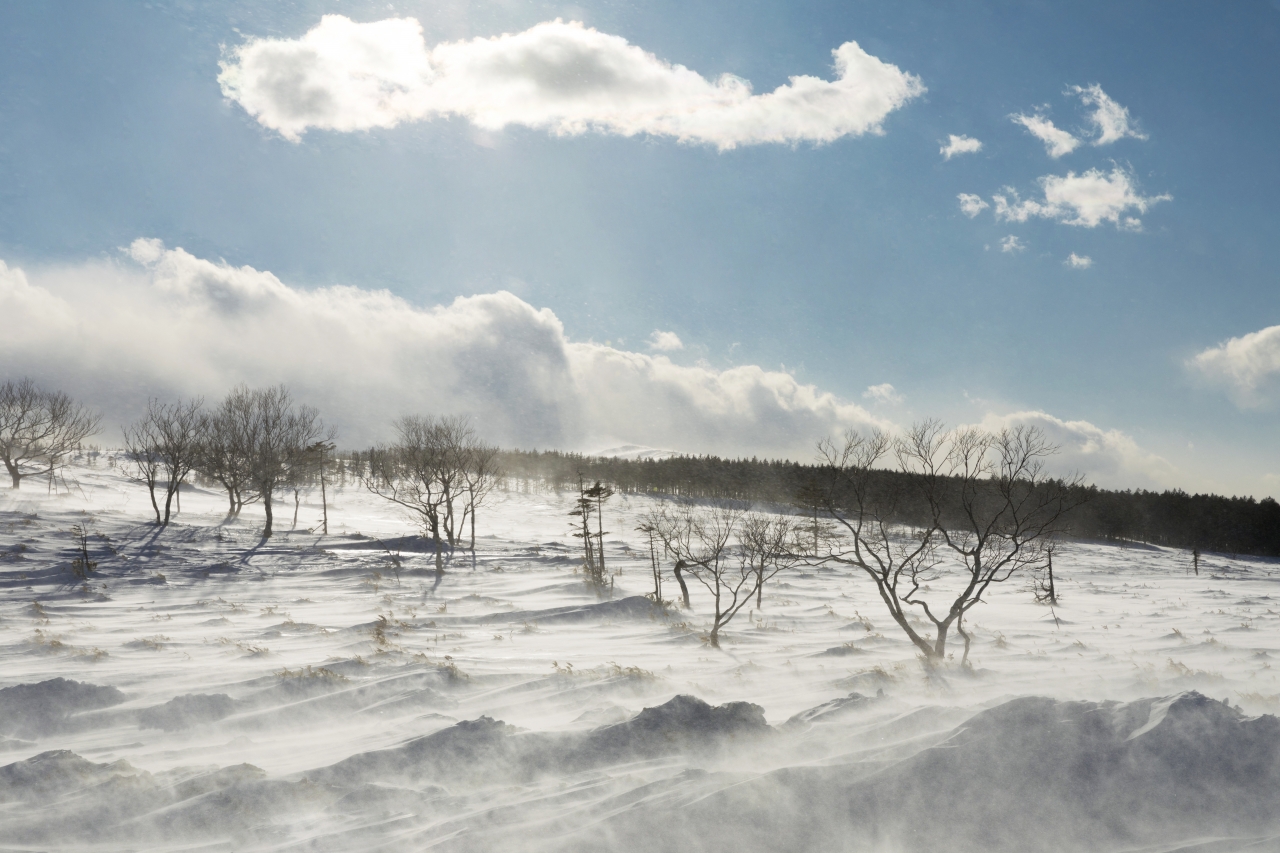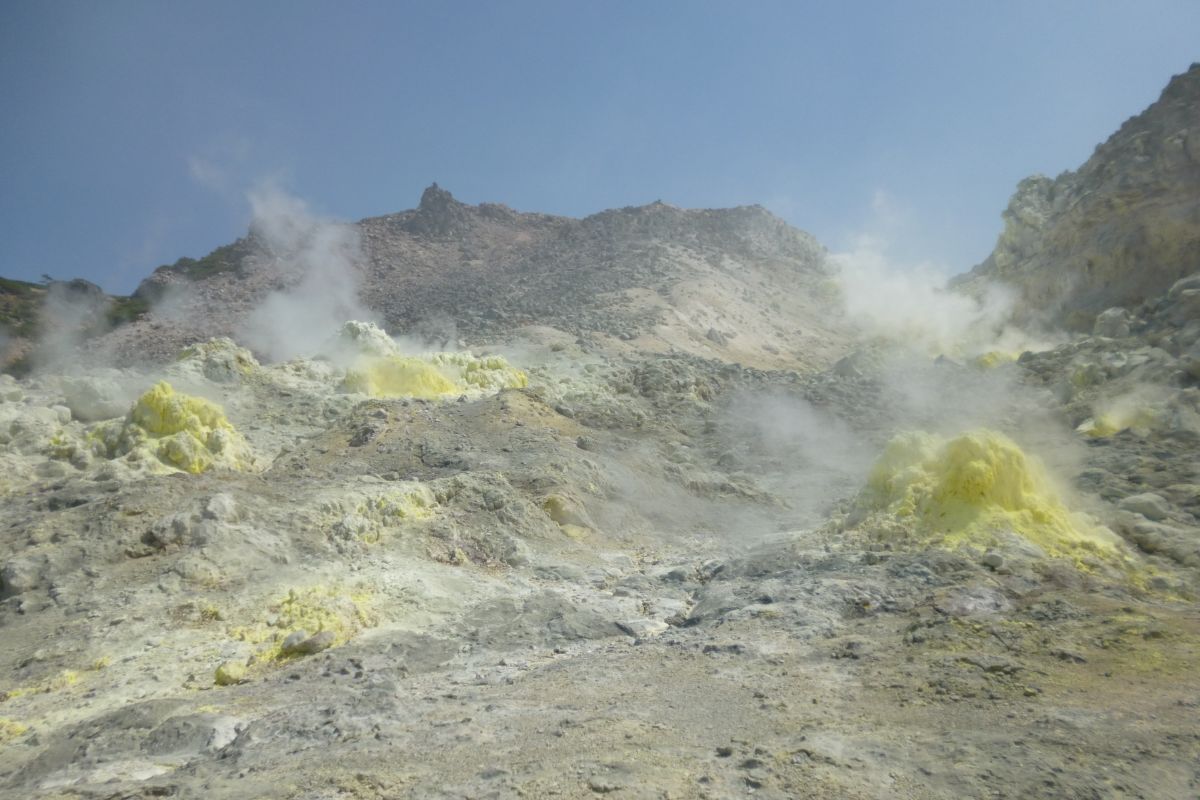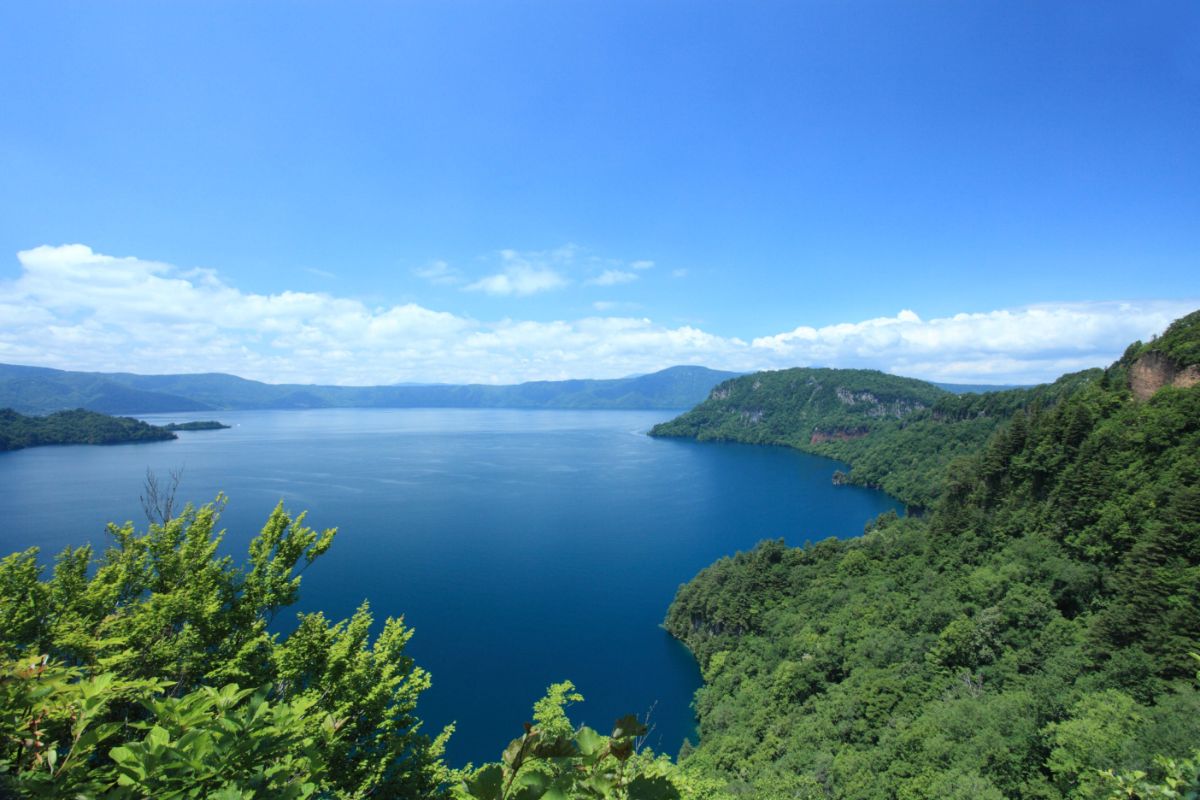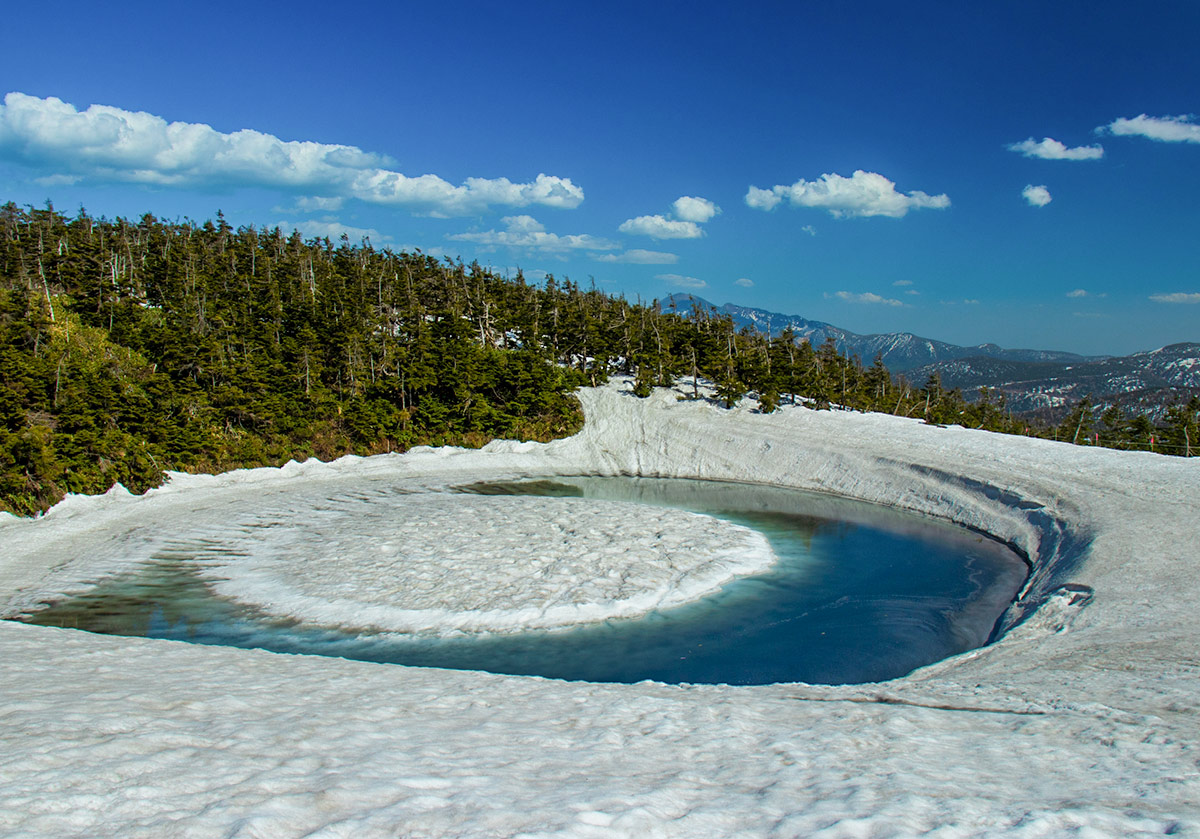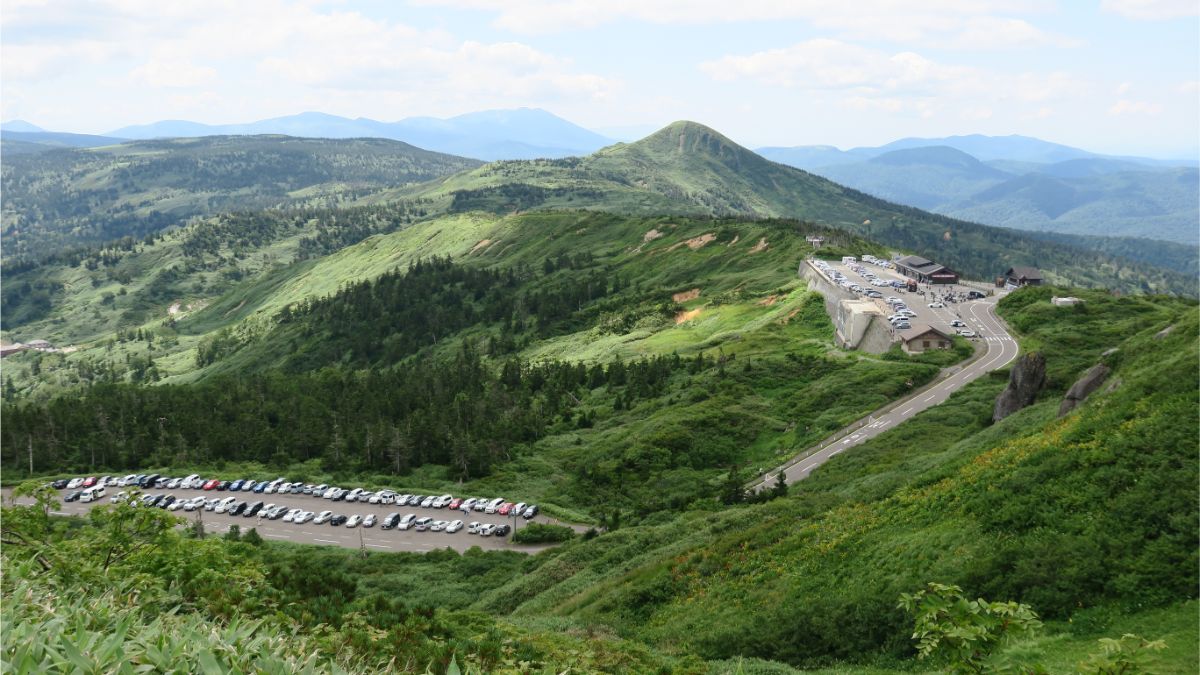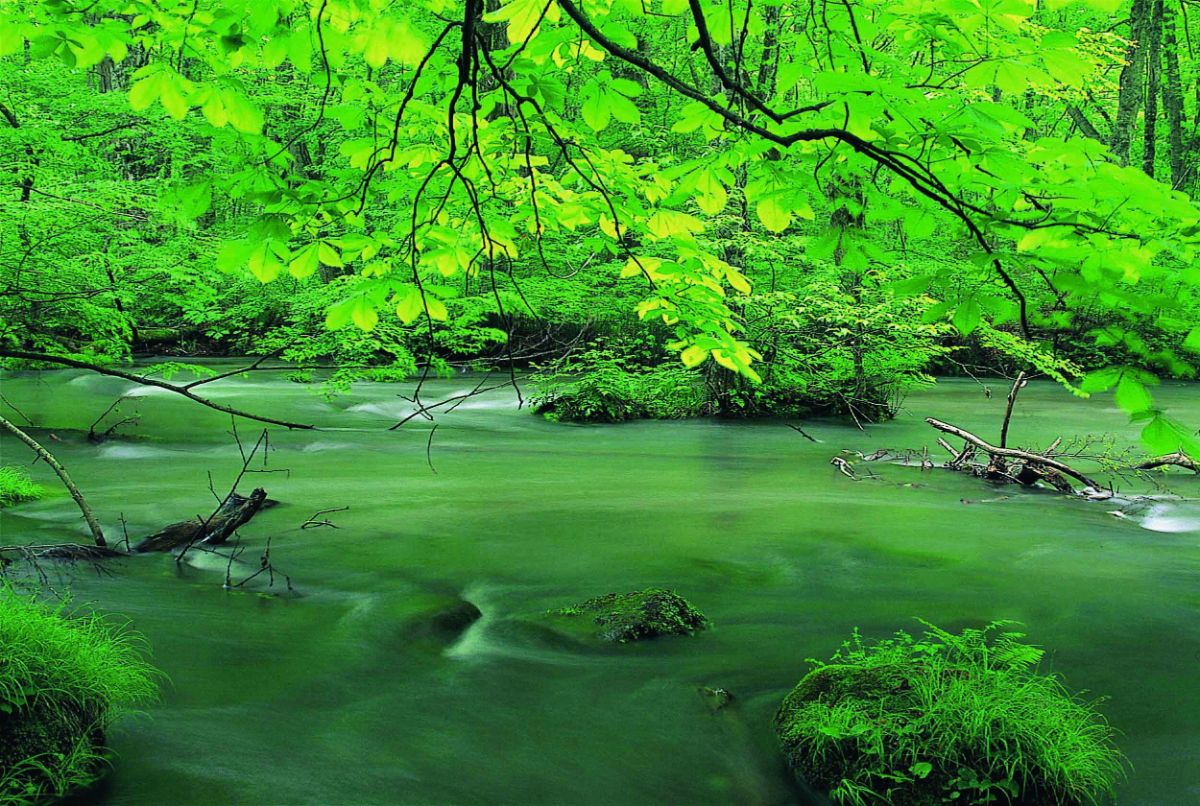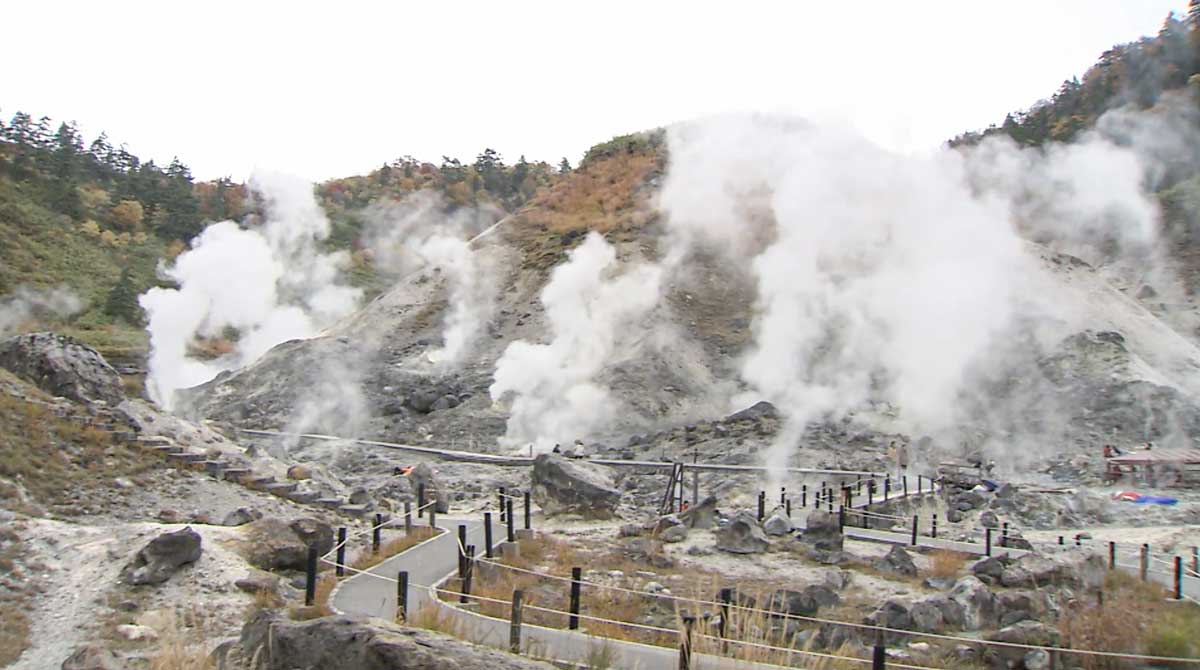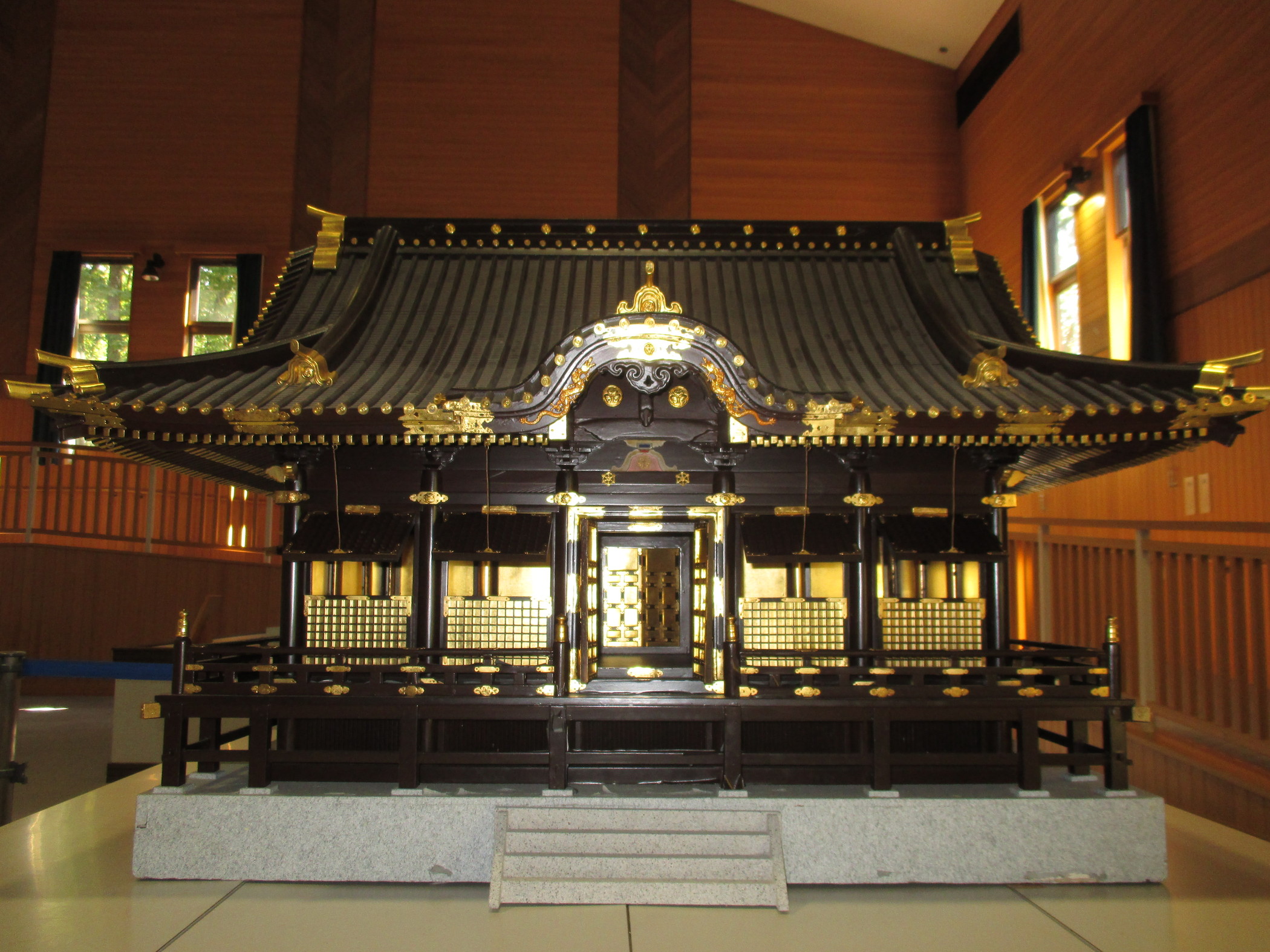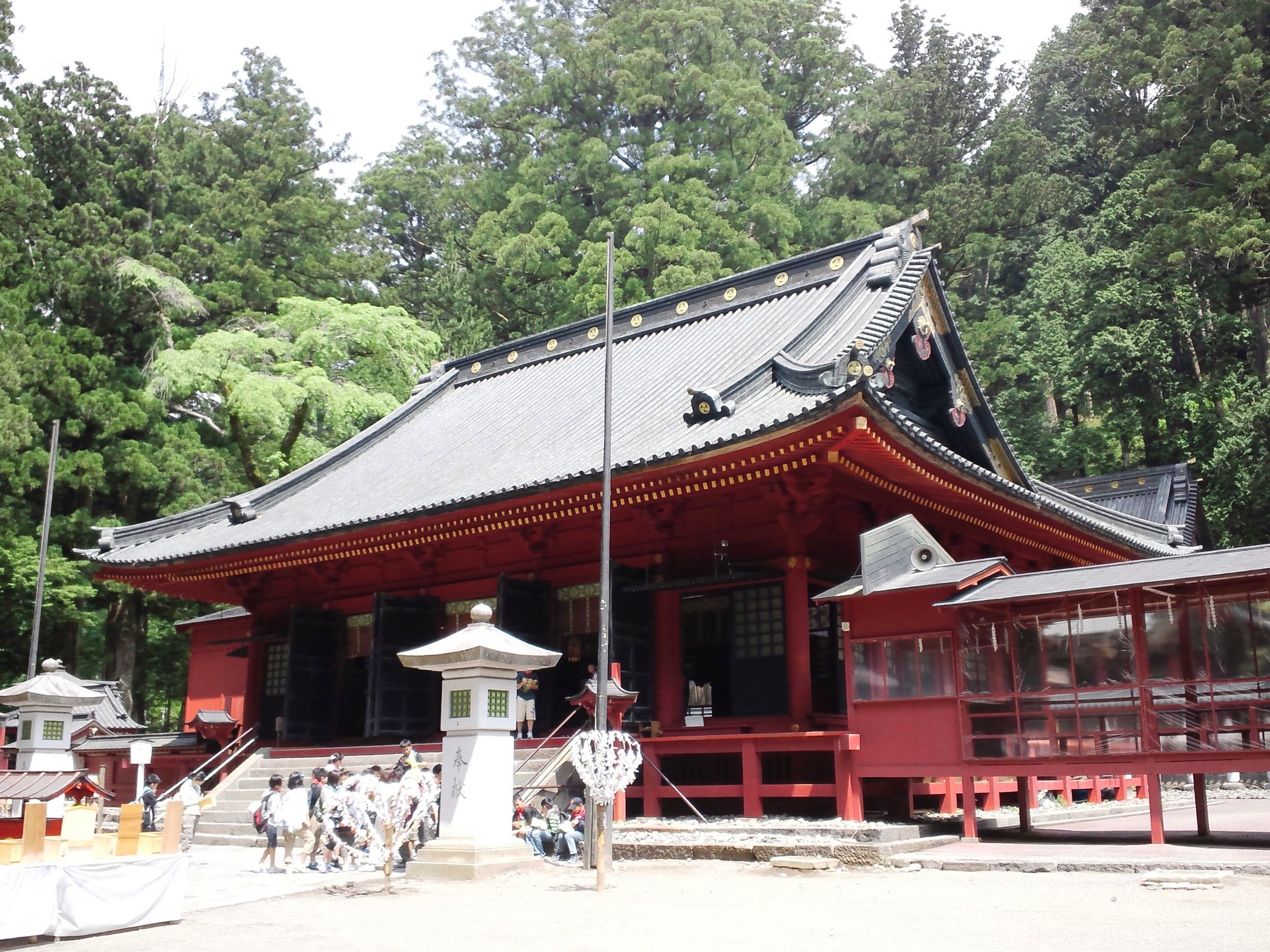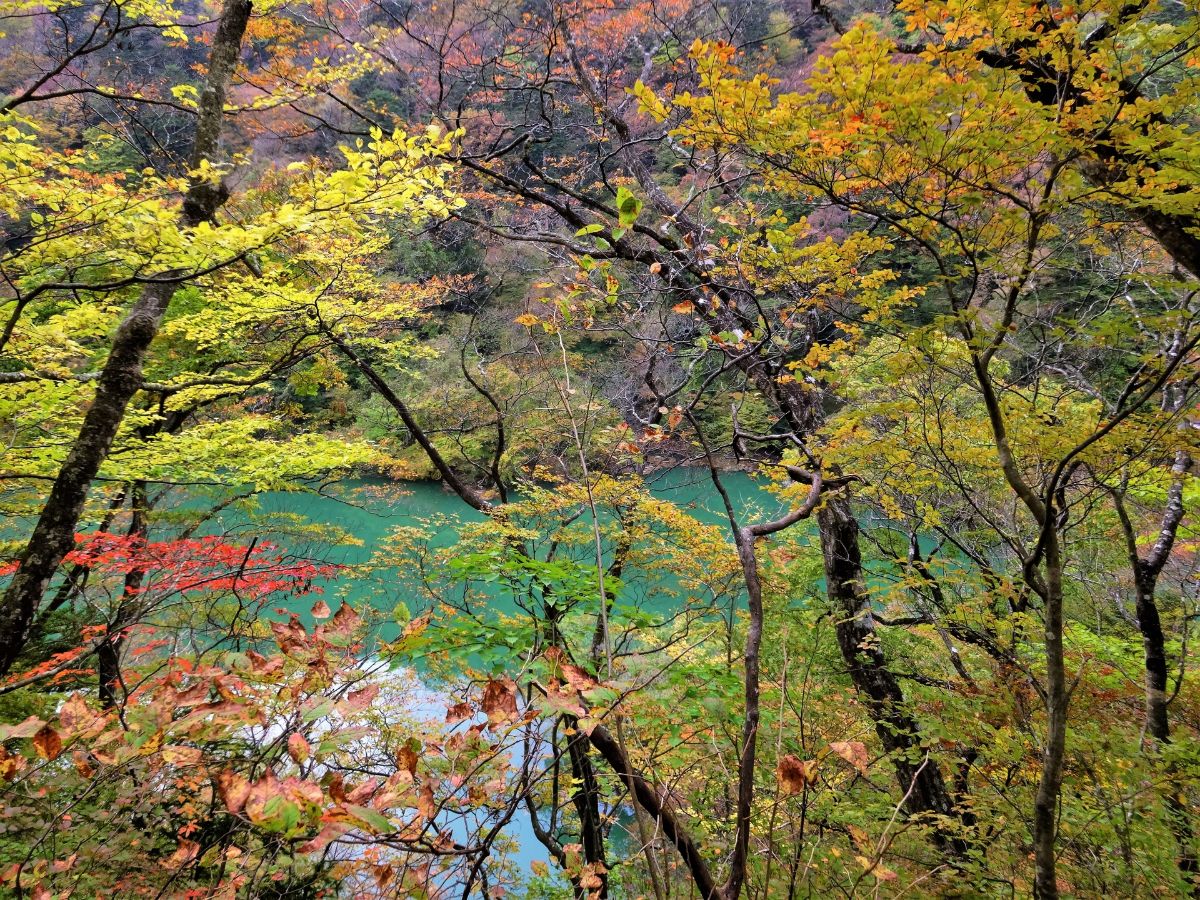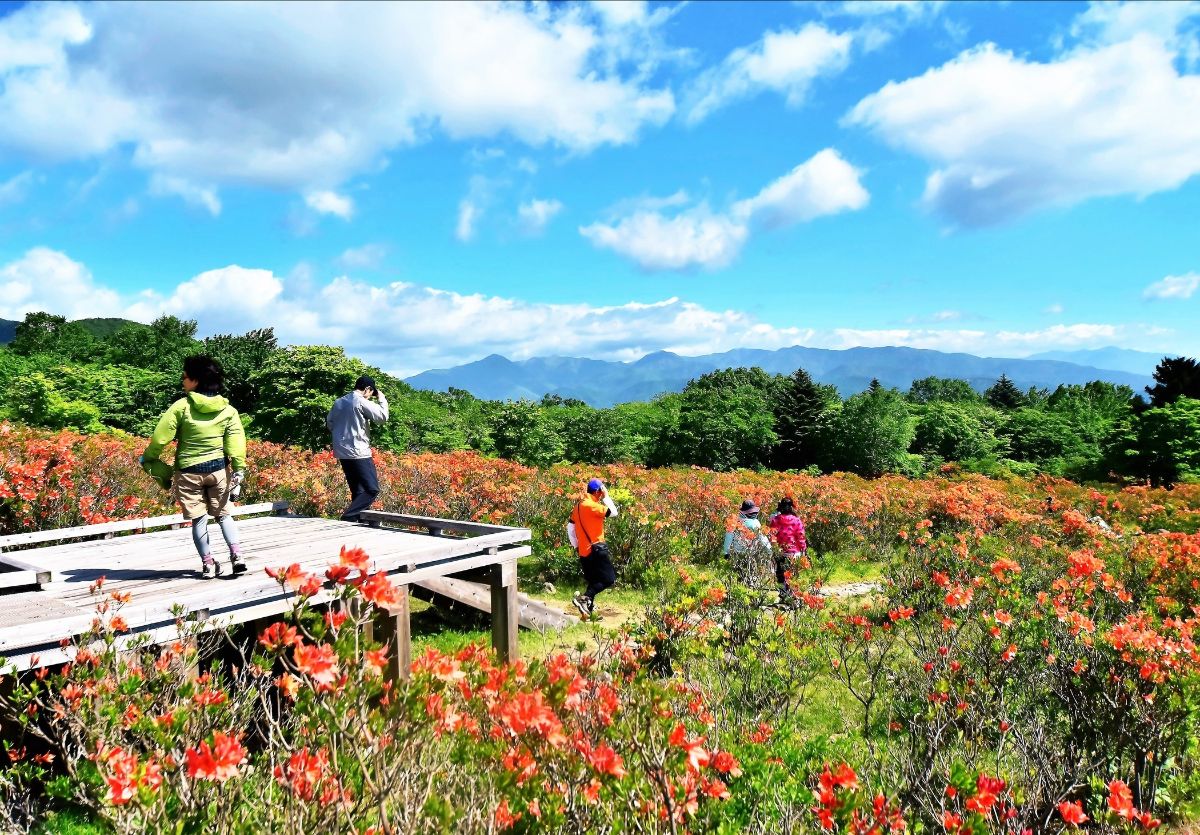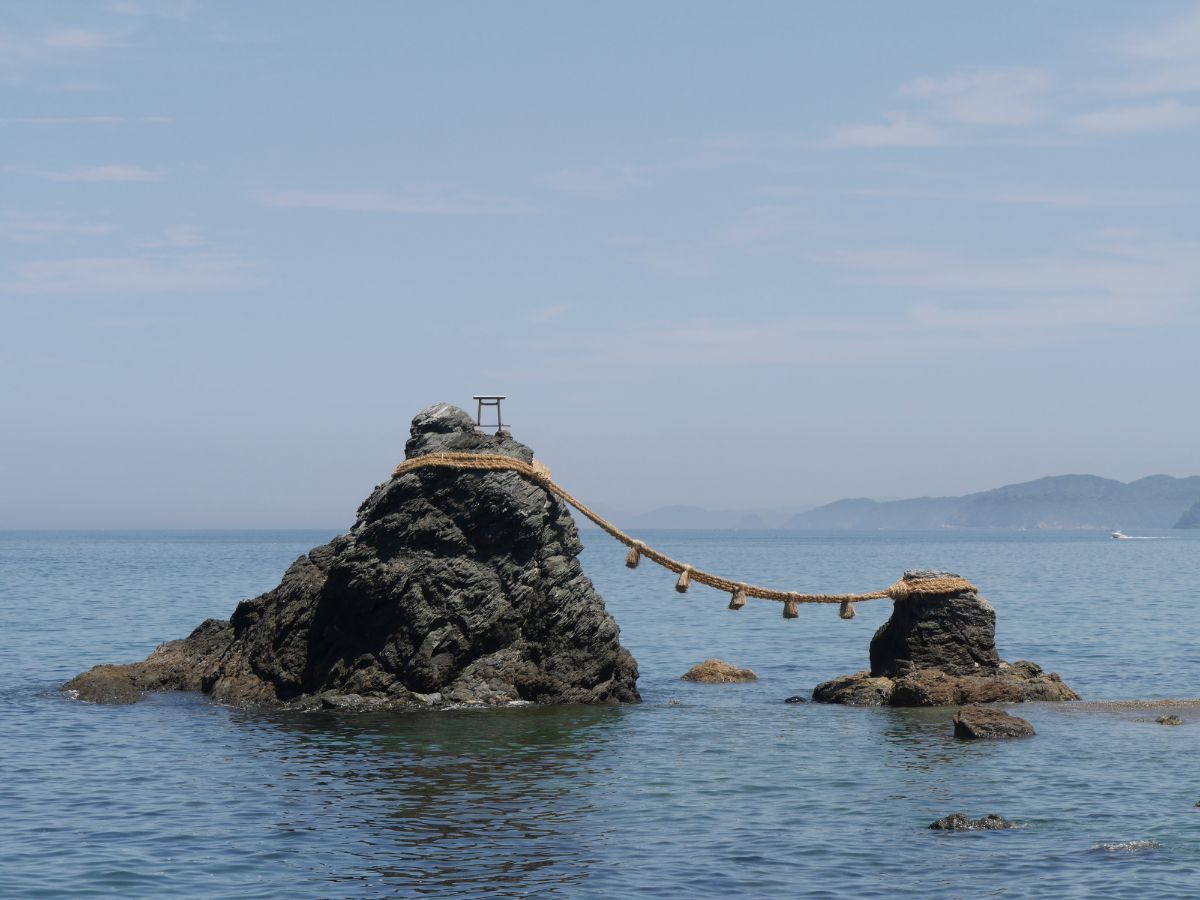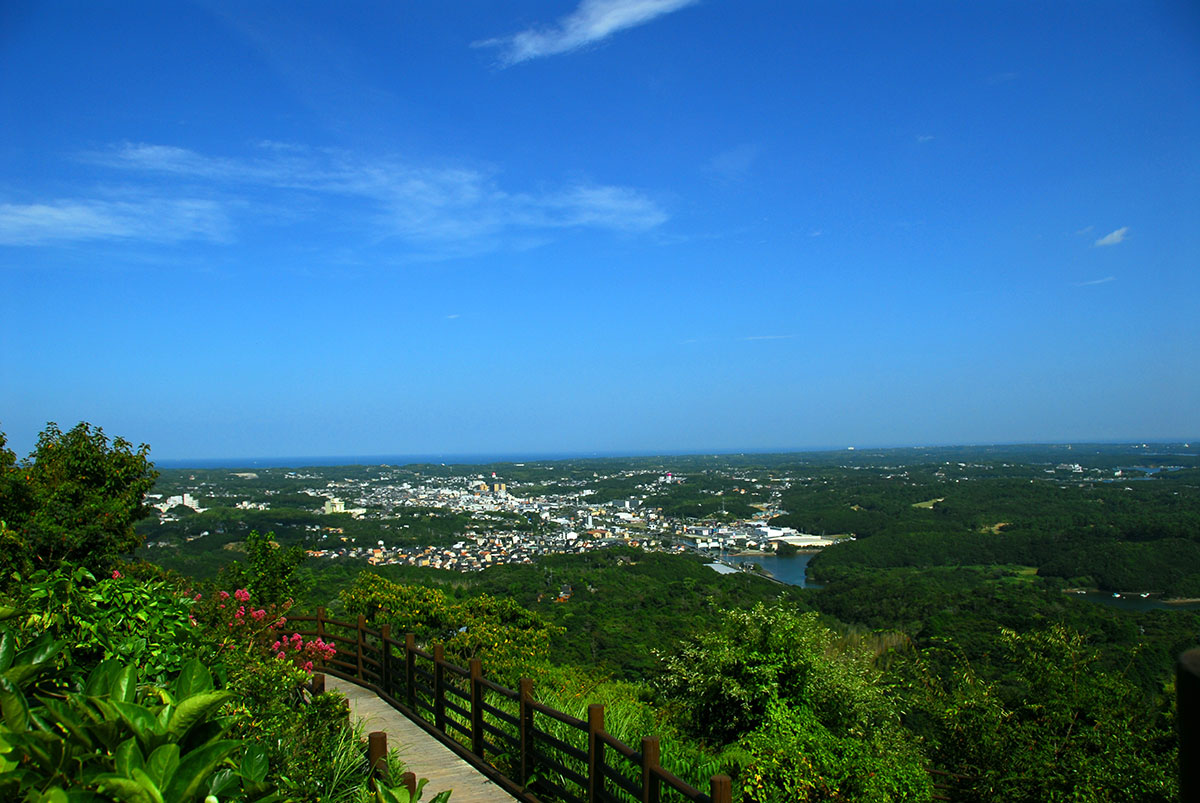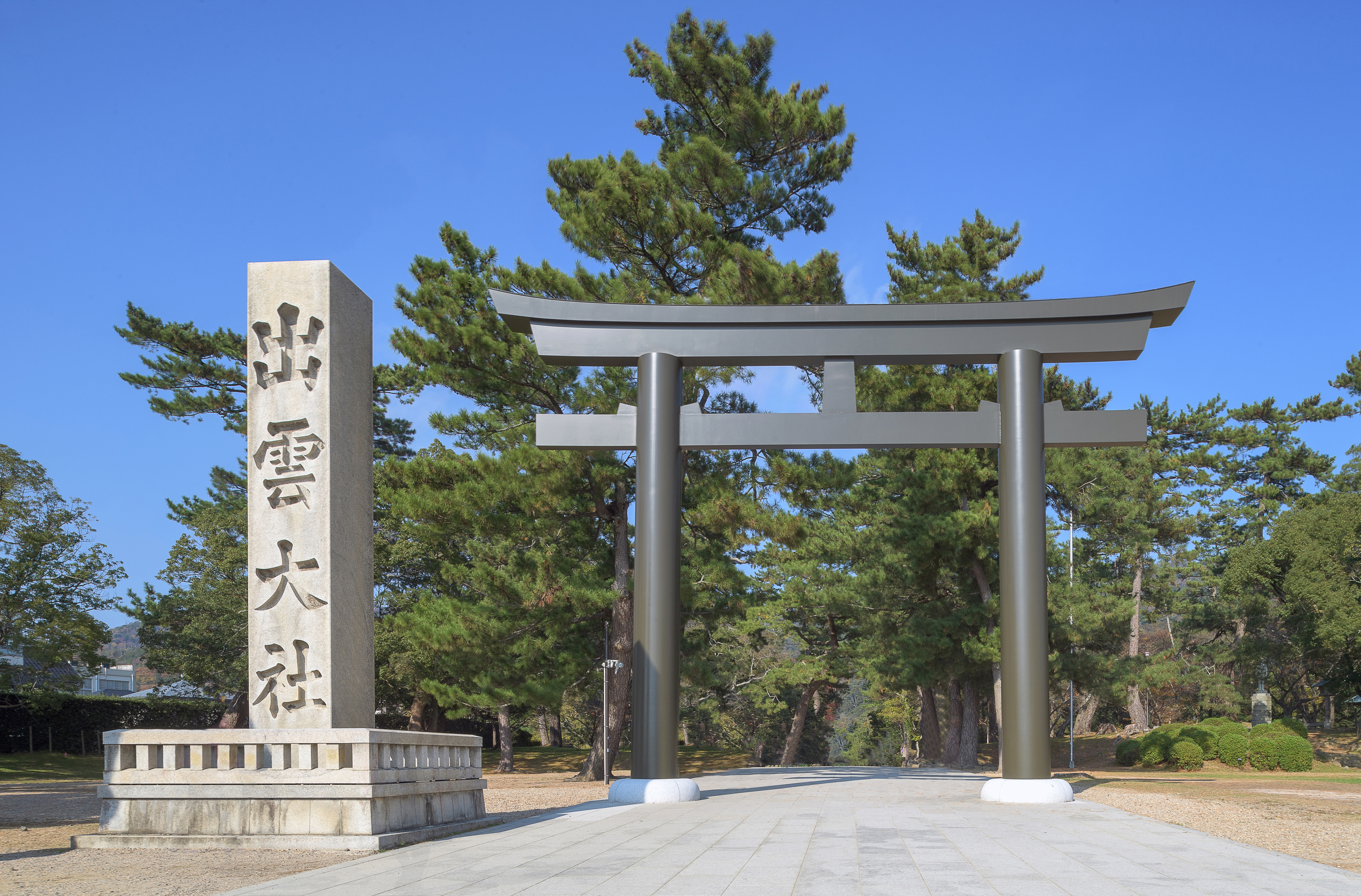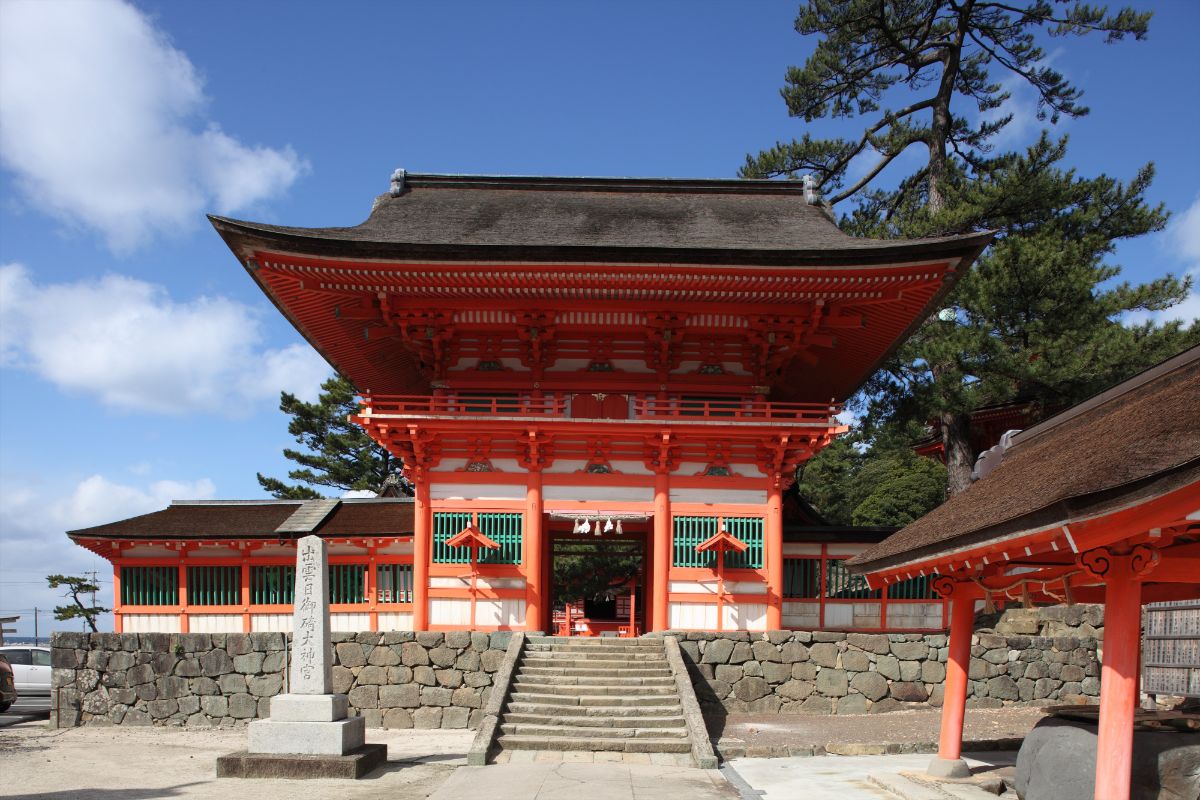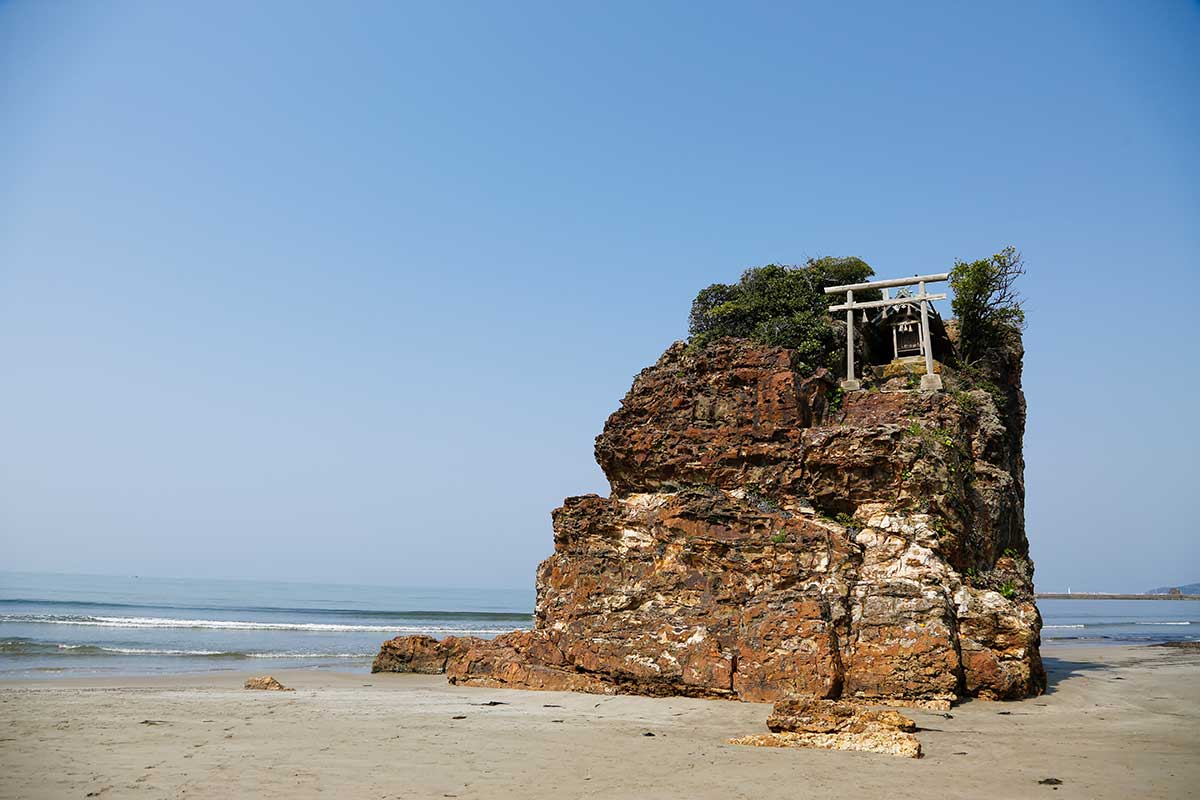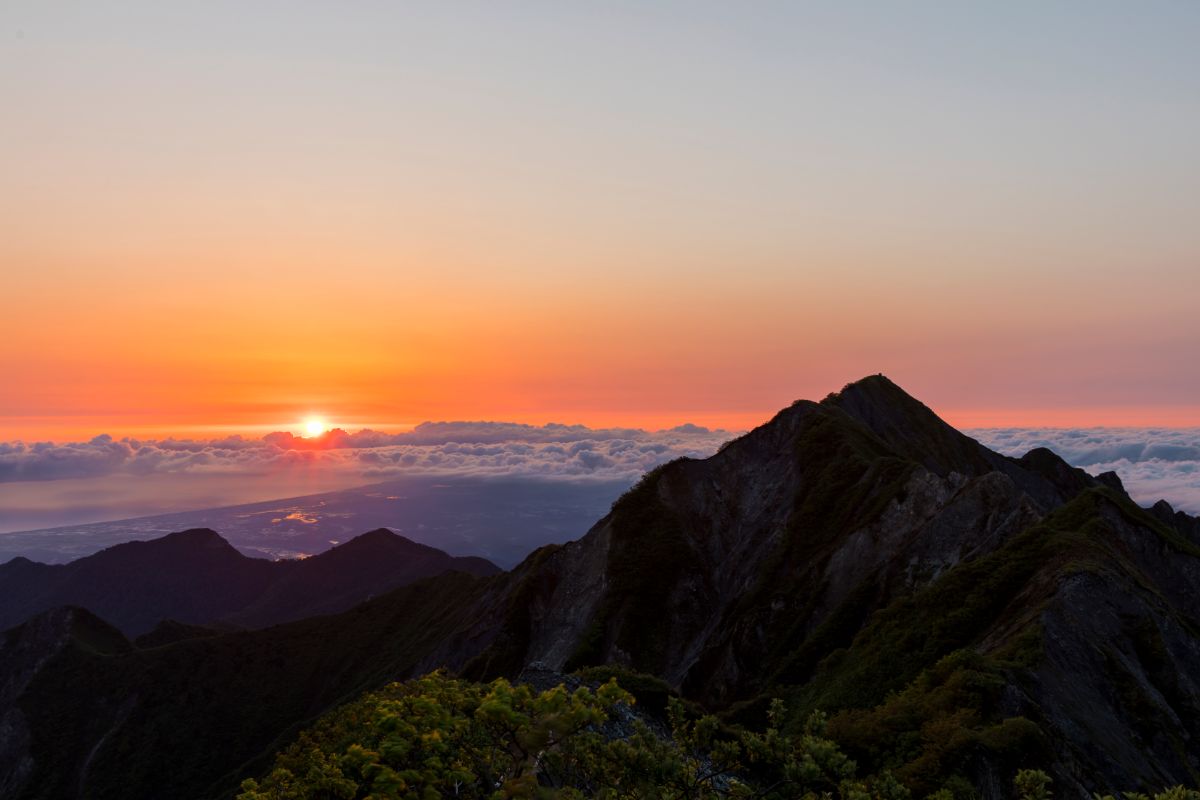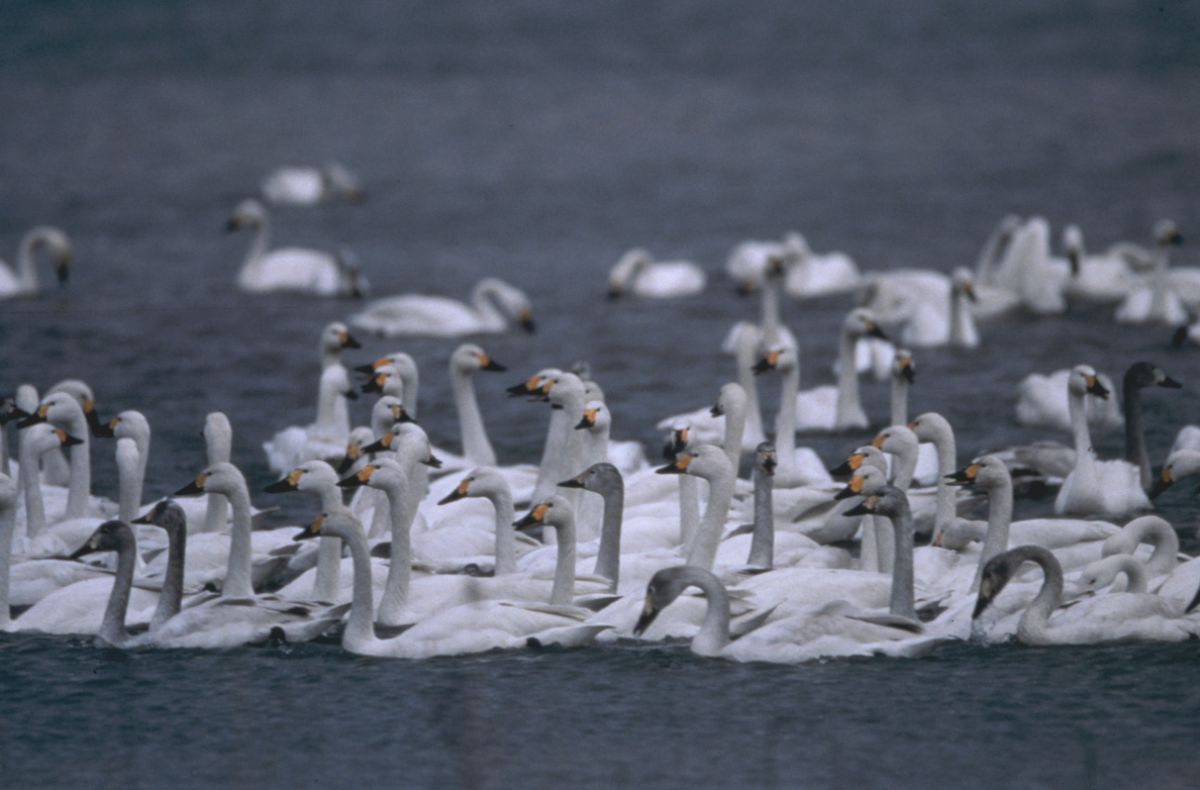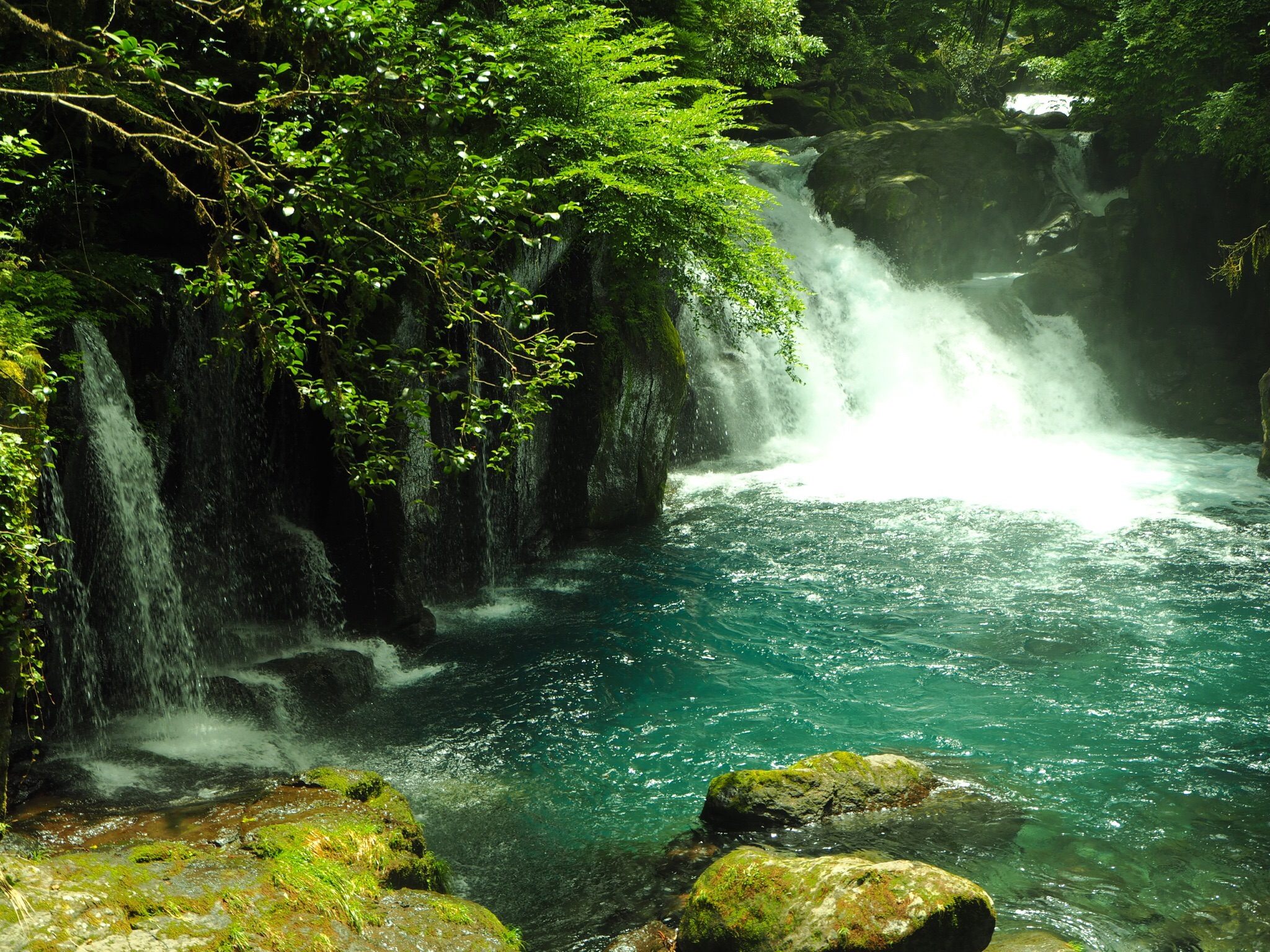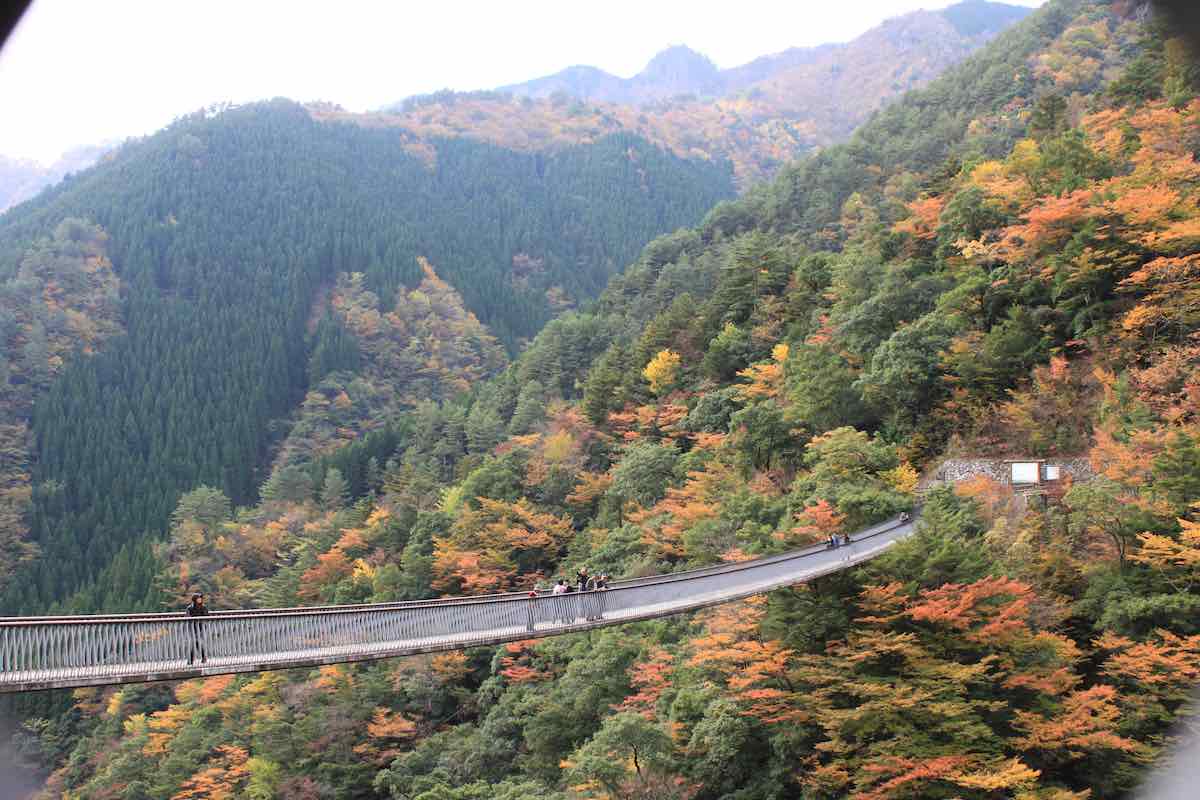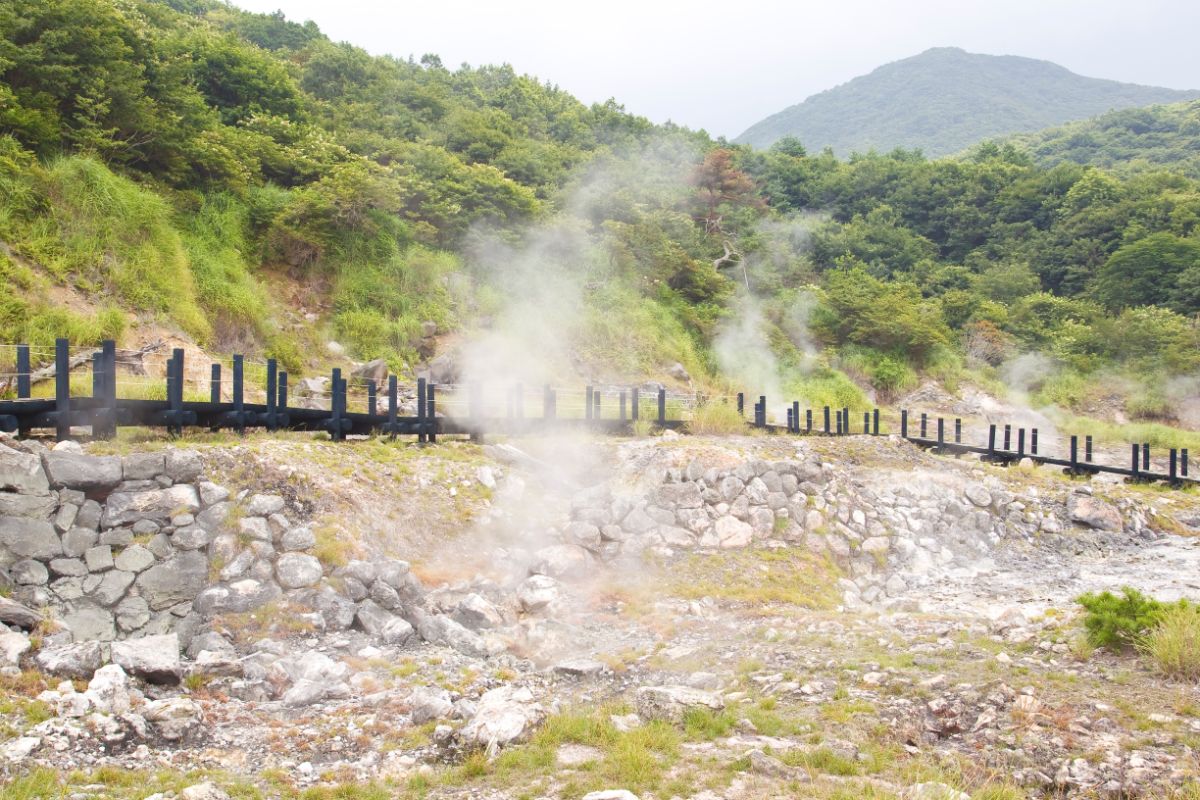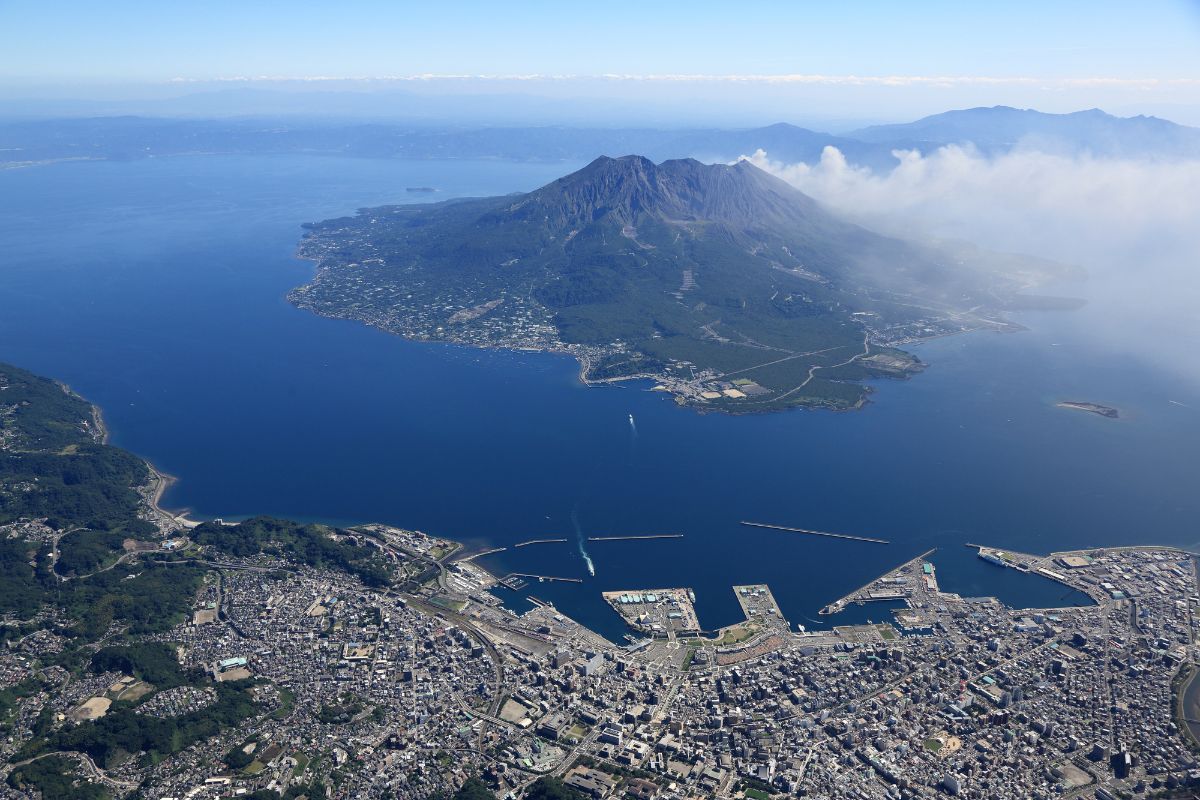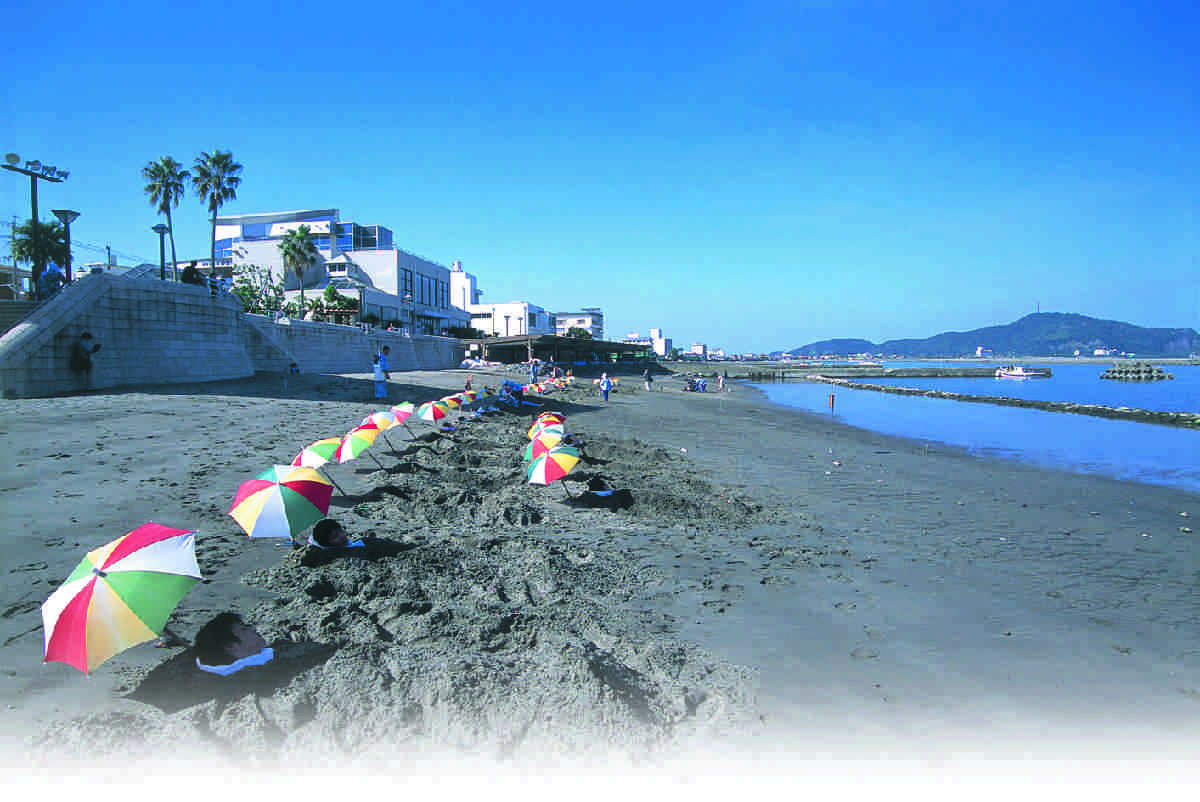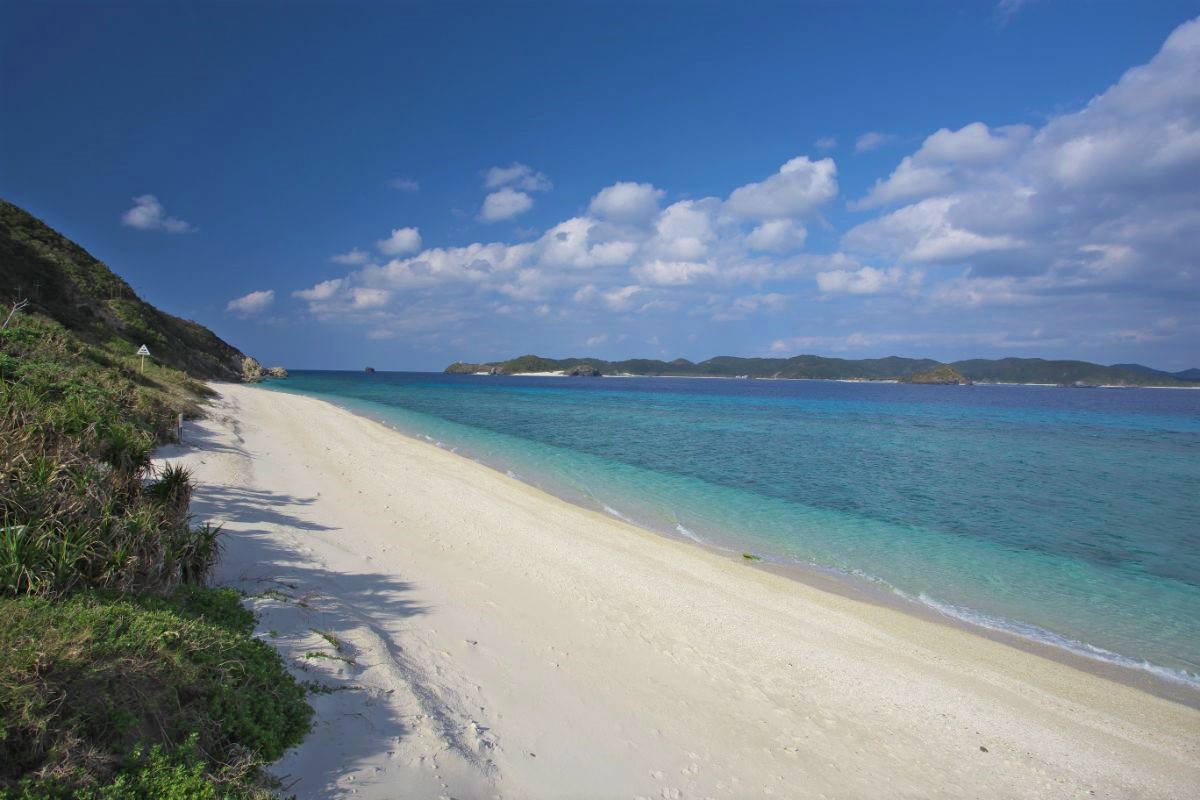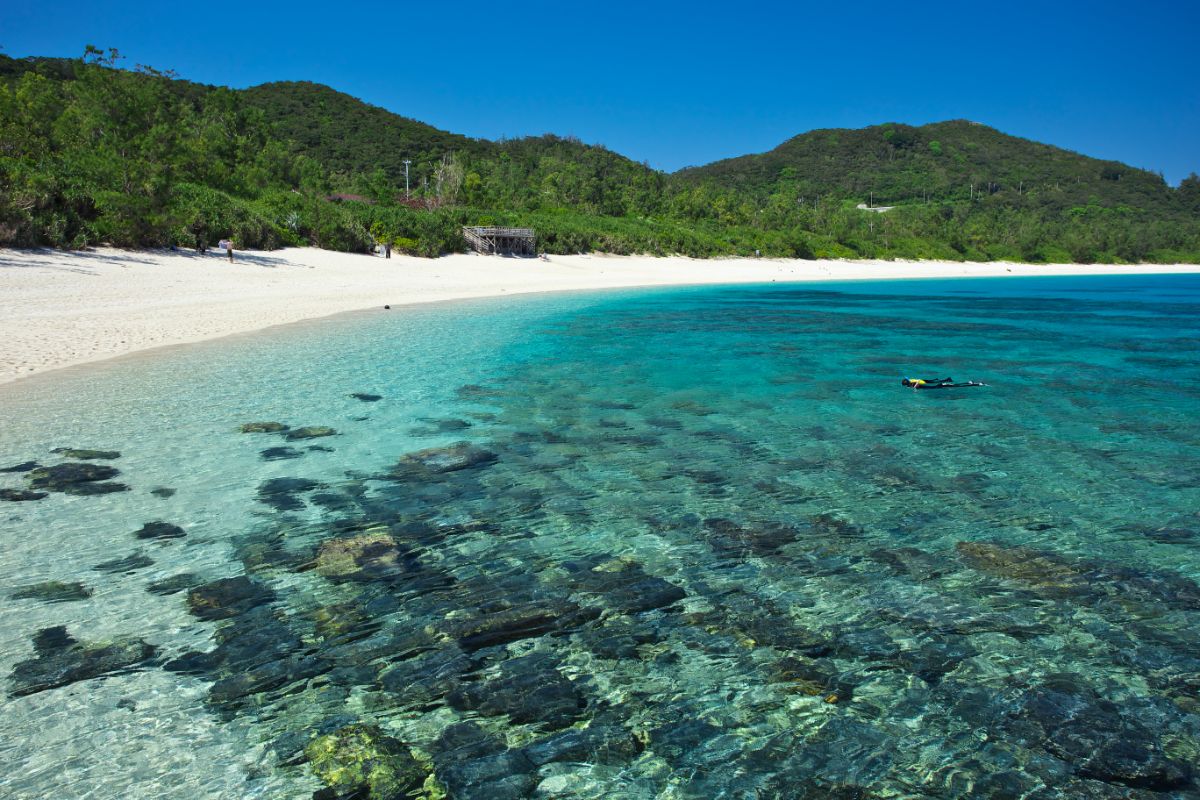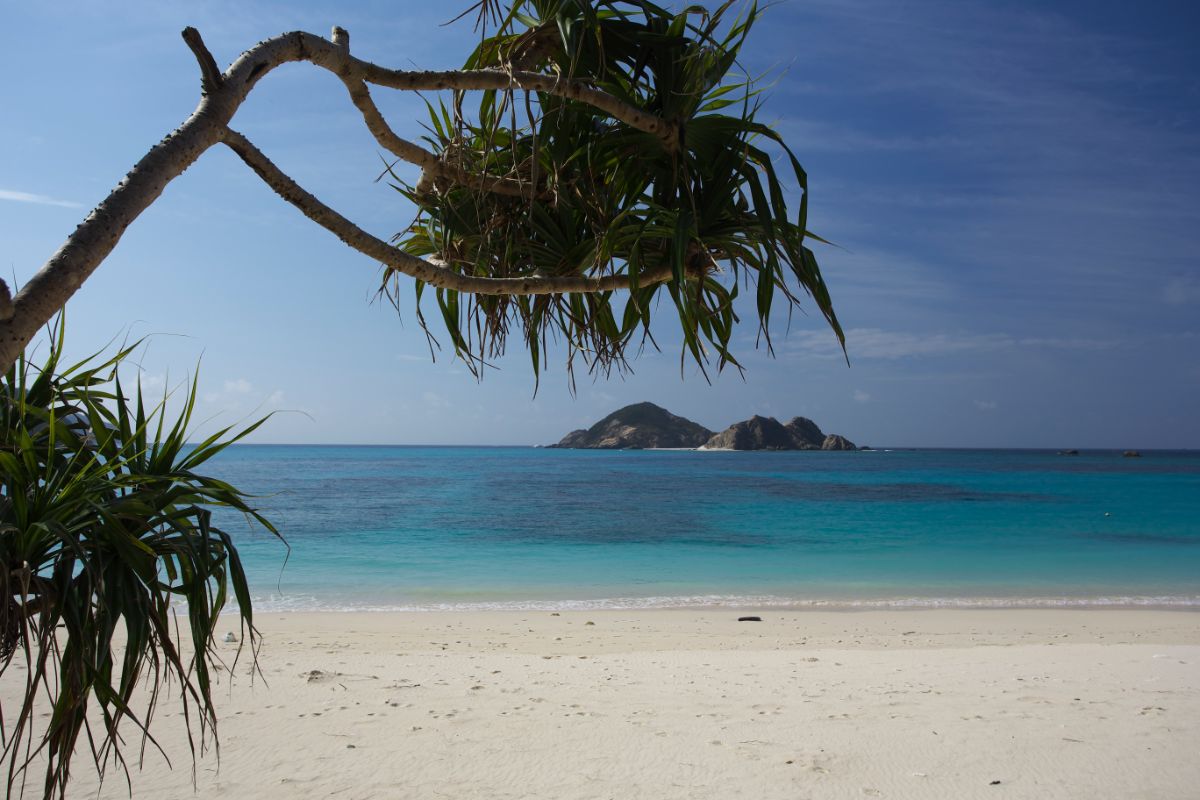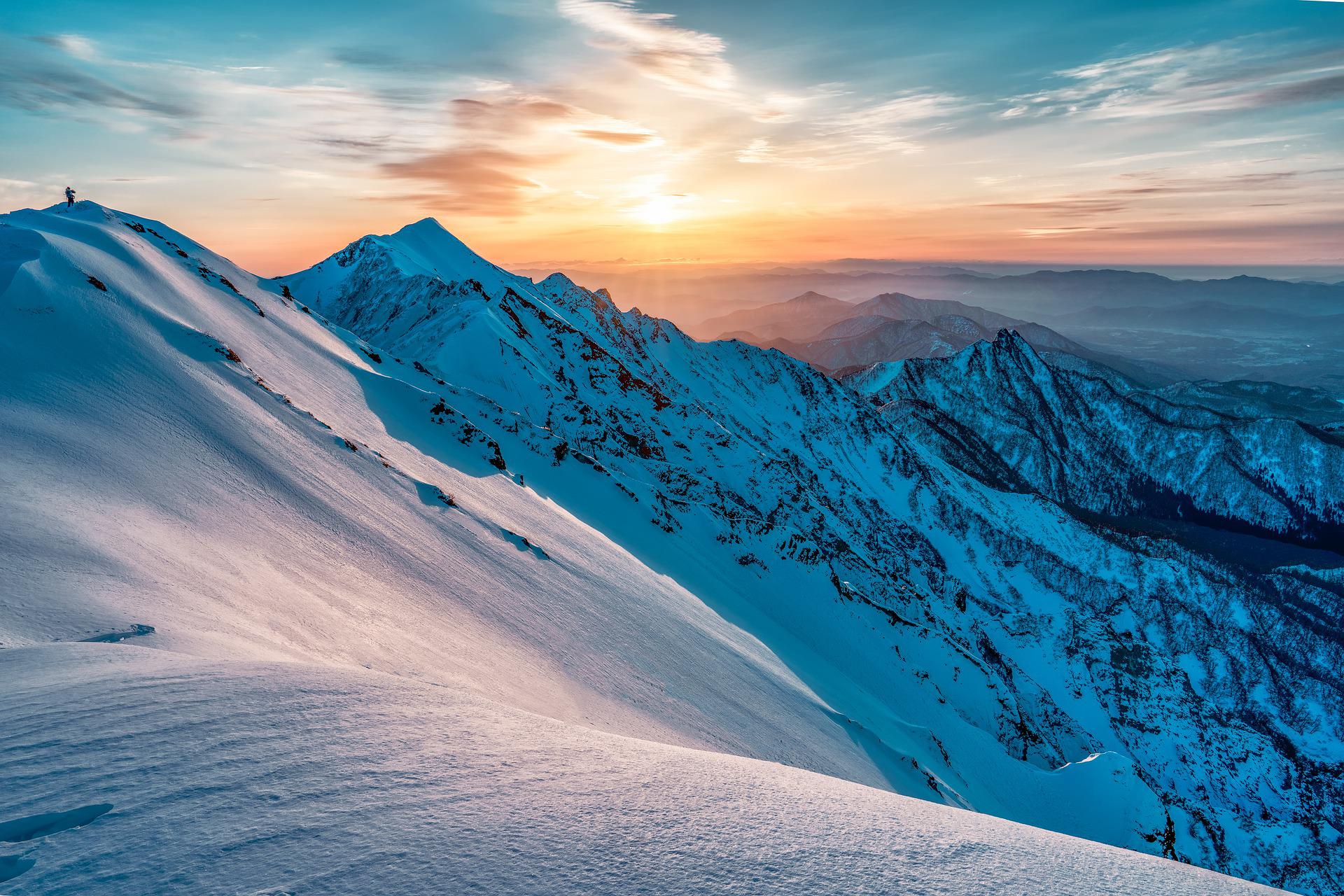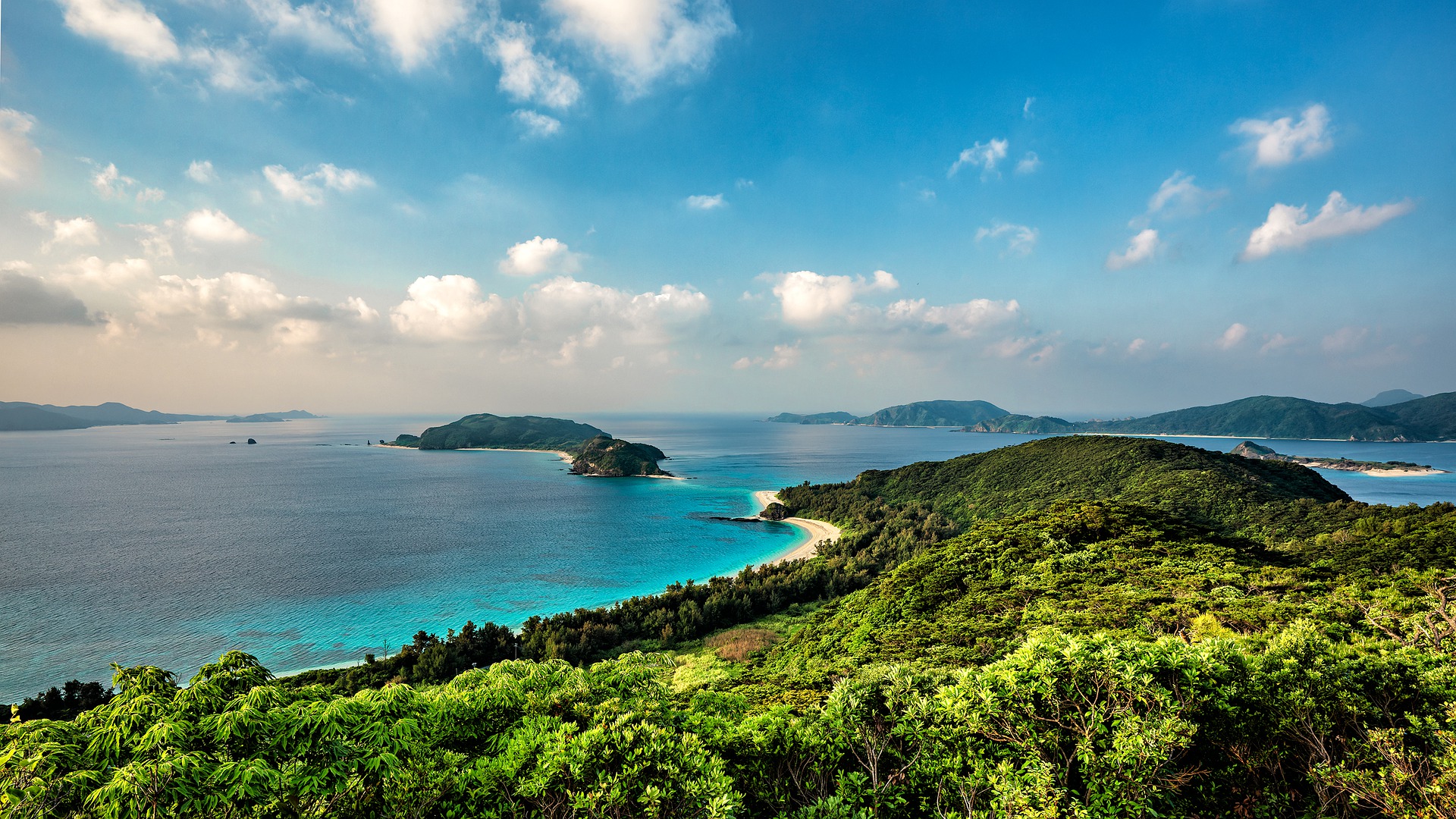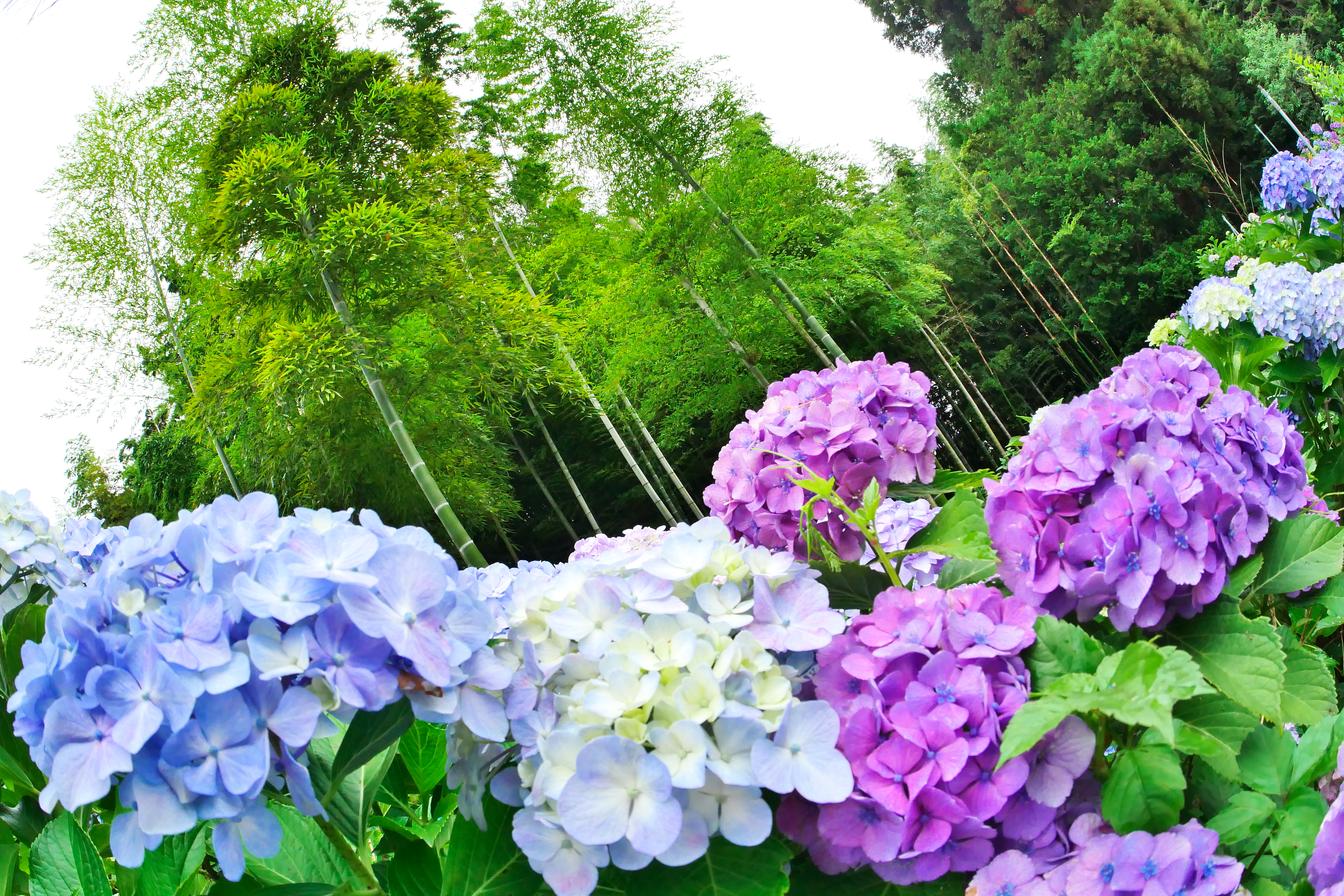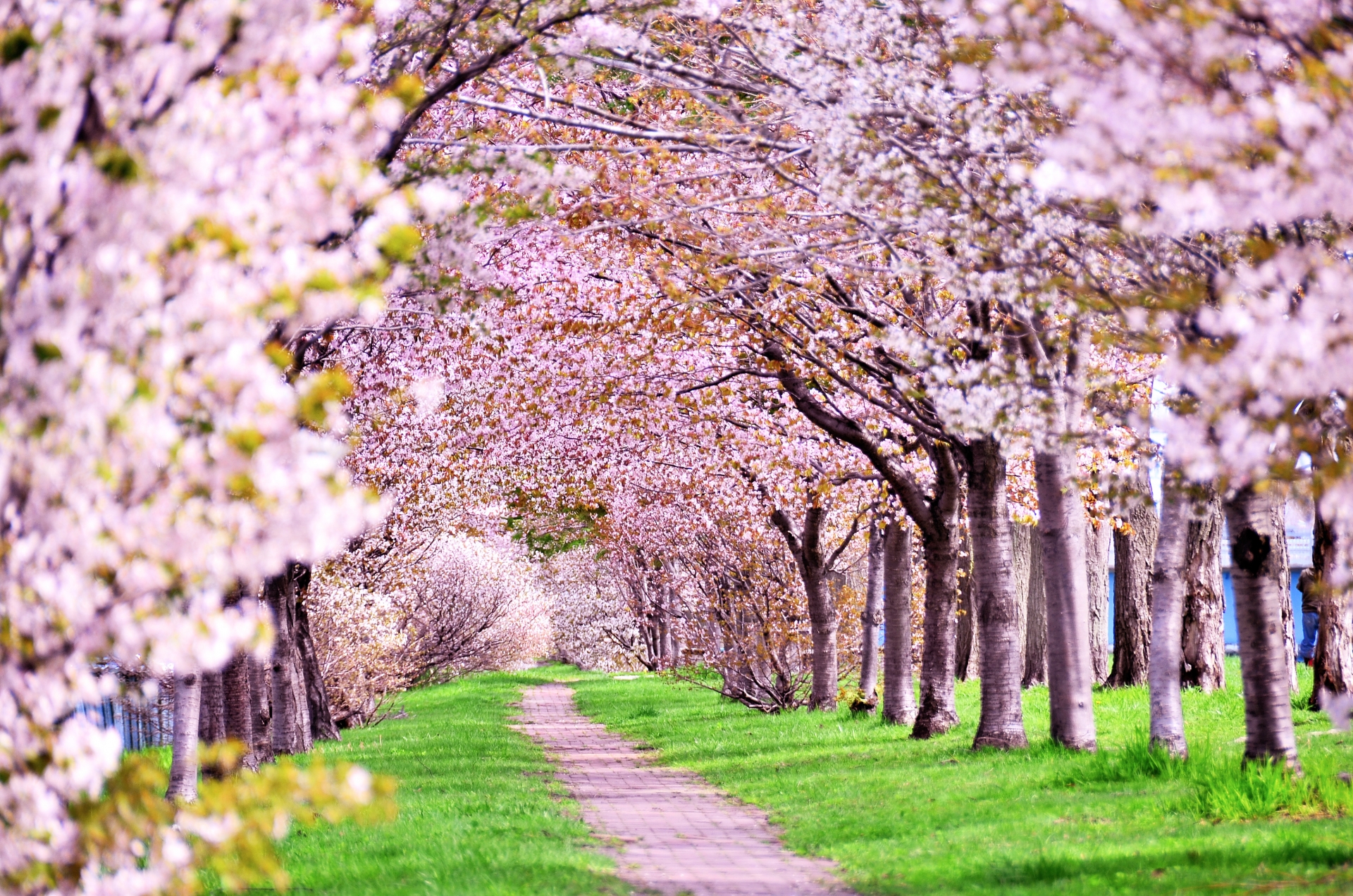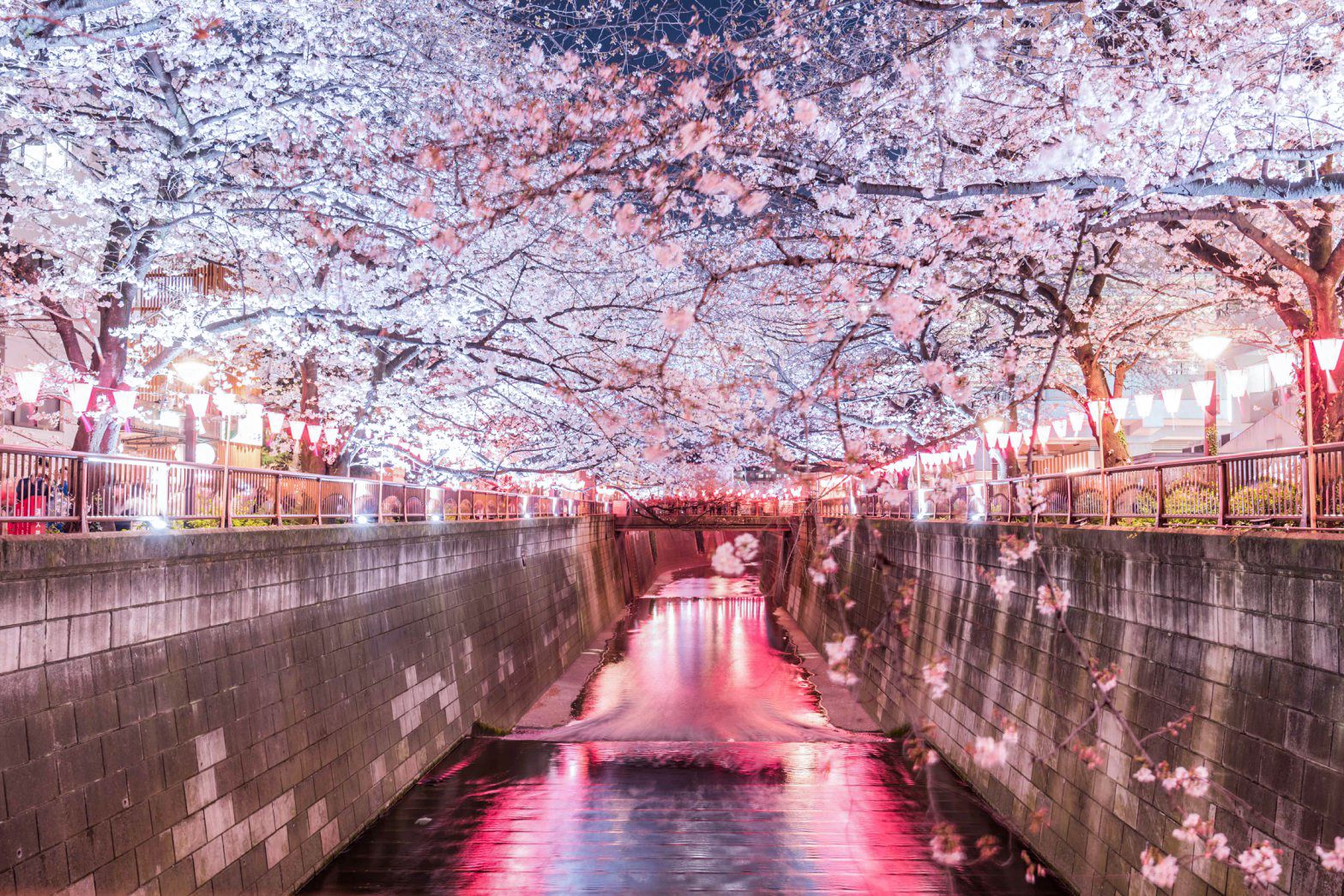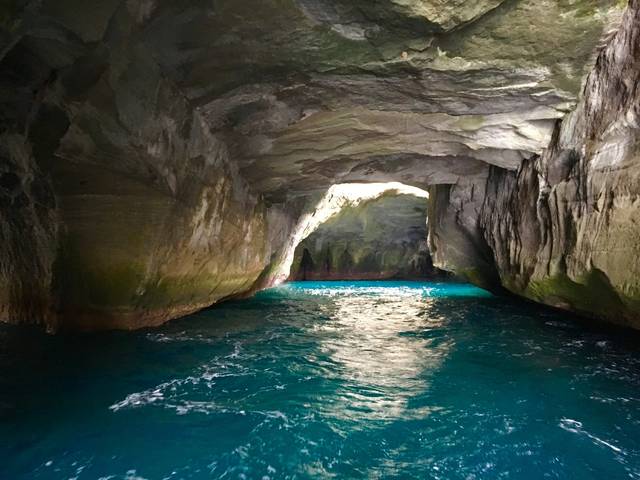8 Japanese National Parks Not to Miss in 2020
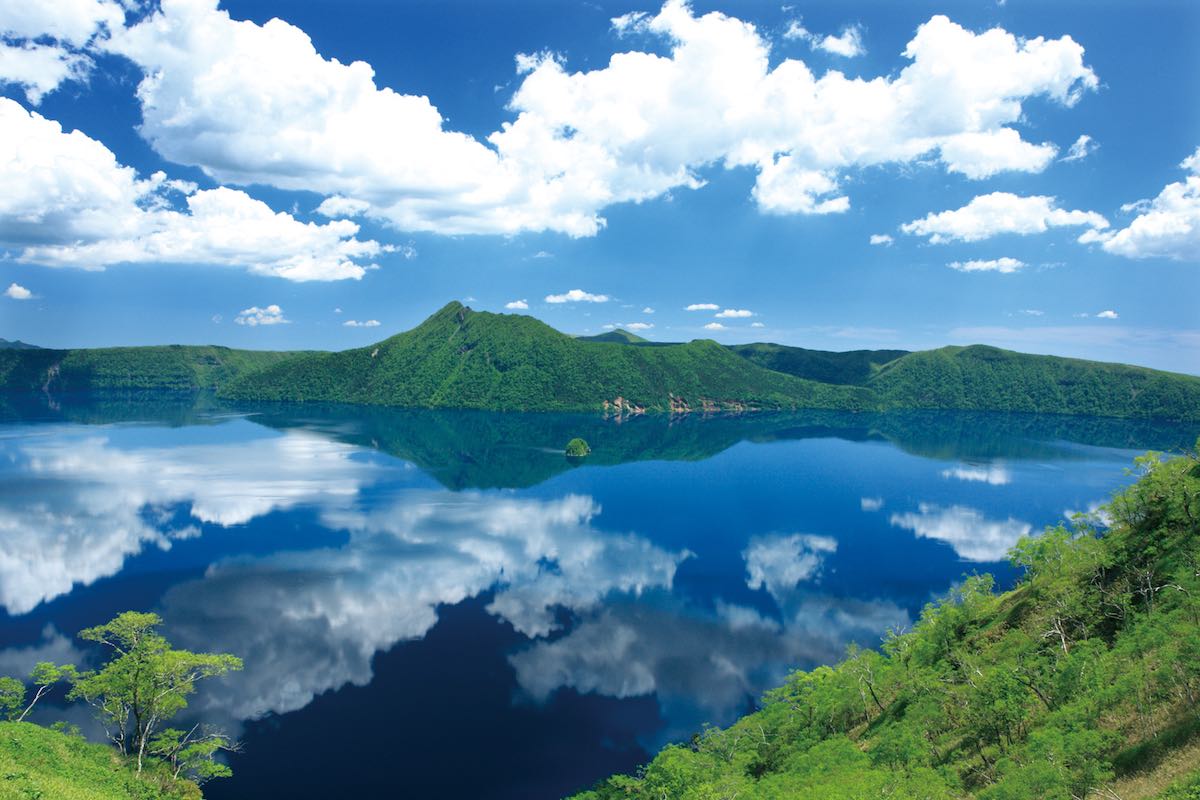
Did you know that, if there were an Olympics for national parks, there are a few that would surely be chosen to represent Japan? With natural beauty that rivals the Grand Canyon National Park in the United States and Snowdonia National Park in Ireland, these are parks that have histories rooted in the lives of Japanese people. Here we will introduce the charms of eight national parks along with the histories and legends of each area.
In preparation for 2020, these eight parks have all been serviced with transportation (easy access), activity and trial facilities, and multilingual services so that travelers can enjoy their visits without any trouble. Be sure not to miss out on enjoying these extraordinary experiences.
With that said, let's have a look!
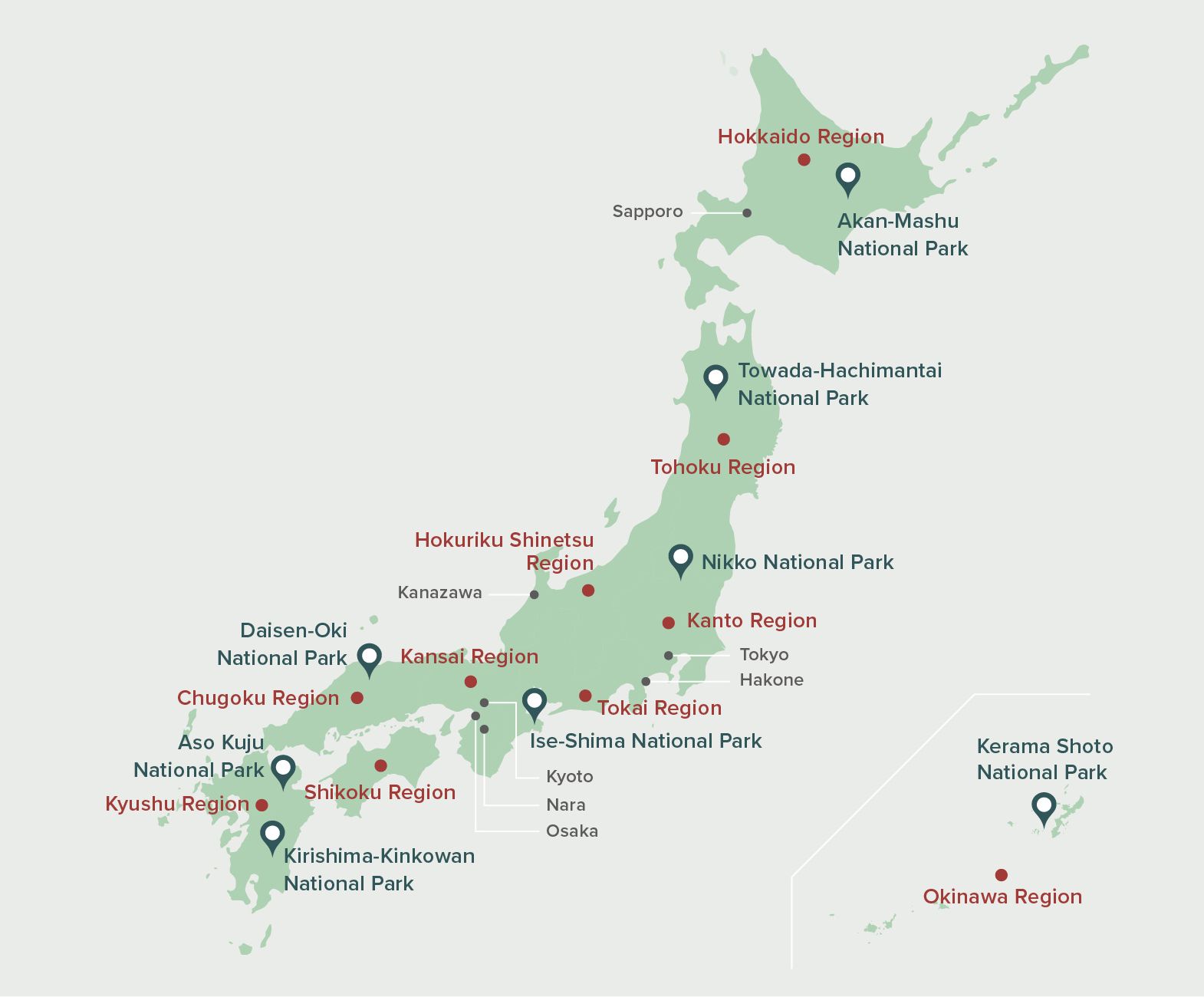
Eight Japanese National Parks
From North to South
- Akan Mashu National Park (Hokkaido)
- Towada-Hachimantai National Park (Akita, Iwate, Aomori)
- Nikko National Park (Fukushima, Tochigi, Gunma)
- Ise-Shima National Park (Mie)
- Daisen-Oki National Park (Tottori, Shimane, Okayama)
- Aso Kuju National Park (Kumamoto, Oita)
- Kirishima-Kinkowan National Park (Furusaki, Kagoshima)
- Kerama Shoto National Park (Okinawa)
# 1. Akan Mashu National Park
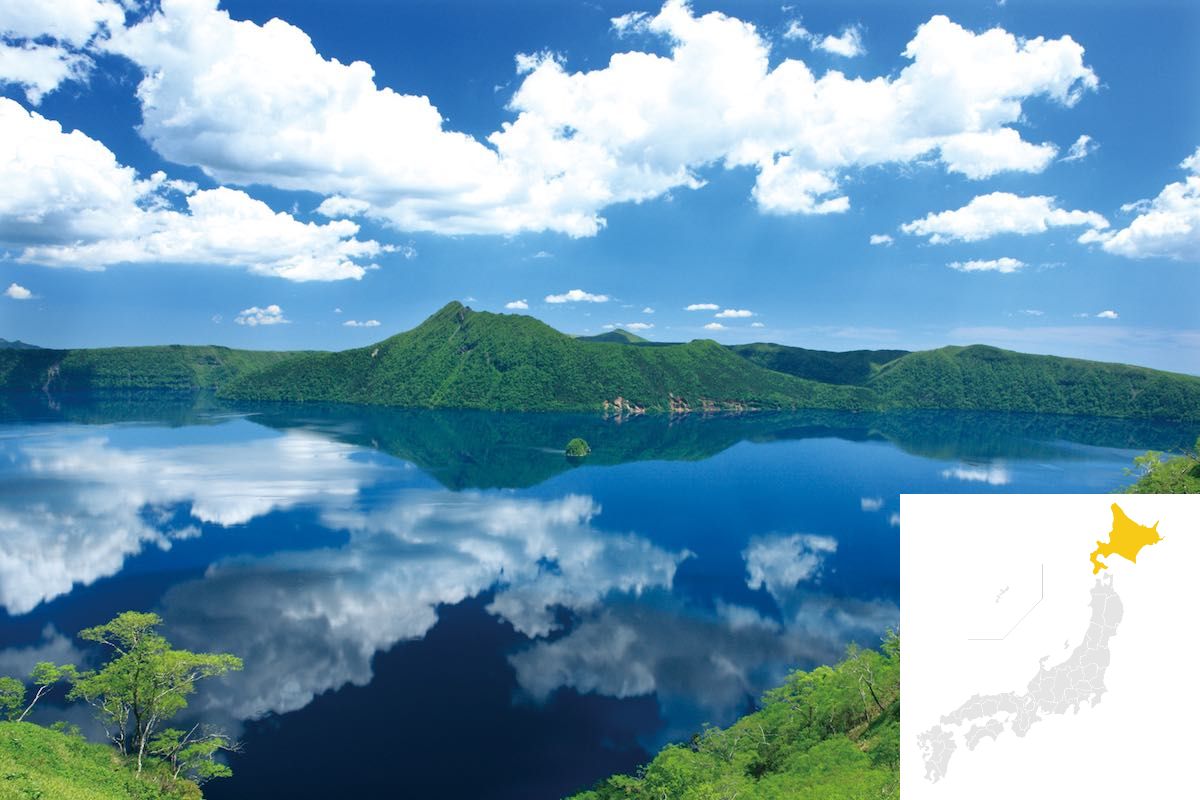
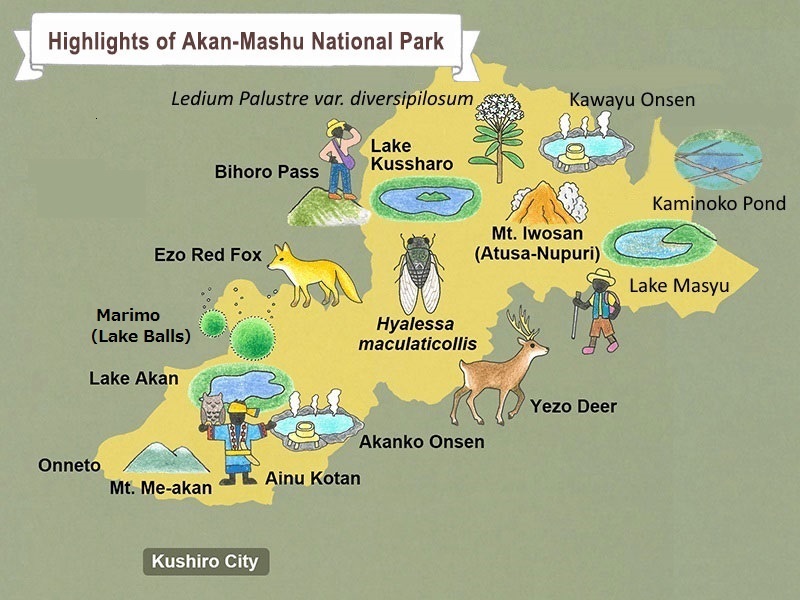
Untouched natural beauty and the lifestyles of indigenous people
Akan Mashu National Park was designated as a national park in 1934, and its history of over 85 years makes it one of the oldest in Japan. The park is a protected nature reserve, and more than 90% of its area is comprised of pristine, untouched natural environments.
The park is covered in a subarctic coniferous(*1) forest, which results in a pristine silhouette. Within the grounds there are also three caldera(*2) lakes that are remnants of volcanic eruptions: Akanko Lake, Kussharoko Lake, and Mashuko Lake. With a number of volcanoes and lakes in close proximity to one another, this area is a valuable geological landmark. Additionally, Kussharoko Lake is the largest caldera lake in all of Japan.
The efforts of Meiji-era Japanese bureaucrat Masana Maeda are to thank for the conservation of this natural environment. In 1906, Masana Maeda set out with a goal to “support agriculture and support livestock farming" and established Maeda Ippoen Foundation to manage agriculture and farms. (The name “Maeda Ippoen” is said to derive from the motto "monogoto banji ni ippo ga taisetsu," which means it is vital to advance and take the first step, whatever the endeavor may be.) However, when Masana saw the harmony between the dense coniferous forests and the beauty of Akanko Lake, he foresaw the development of the area as a sightseeing spot. He proclaimed, "These mountains must not be cut through; they must be admired." He devoted his own funds and contributed to road excavation and the construction of educational institutions as well as a variety of other facilities. In later years, striving for nature conservation and the promotion of social services, Masana’s daughter-in-law, Mitsuko, made the land free of charge. This paved the way for the livelihood and education of the indigenous Ainu people of Hokkaido and led to the formation of Ainu settlements. Even now, Ainu-Kotan, which consists of about 30 houses and is the largest Ainu village in Hokkaido, can be found on the west side of Akanko Lake’s hot spring town.
In addition to the natural beauty of the area, you can enjoy learning about the ages-old livelihood and culture of the Ainu people, visit folk-craft shops, and indulge yourself in Hokkaido and Ainu cuisine.
(*1)coniferous: trees that grow in extremely cold climates and have small needles as leaves
(*2)caldera: a geological feature comprised of a region of collapsed terrain formed when large amounts of magma are ejected during a volcanic eruption
“Onneto” is a lake located on the westernmost point of Akan Mashu National Park which means “old ...
Bihoro Pass is located in Akan Mashu National Park. The Route 243 of the mountain pass has an ele...
Mt. Io is also known as “Atosanupuri” which means “a naked mountain” in Ainu language. It is a mo...
Access
*Depending on the weather conditions, roads may close due to snow, so please check weather and traffic information in advance.
# 2. Towada Hachimantai National Park
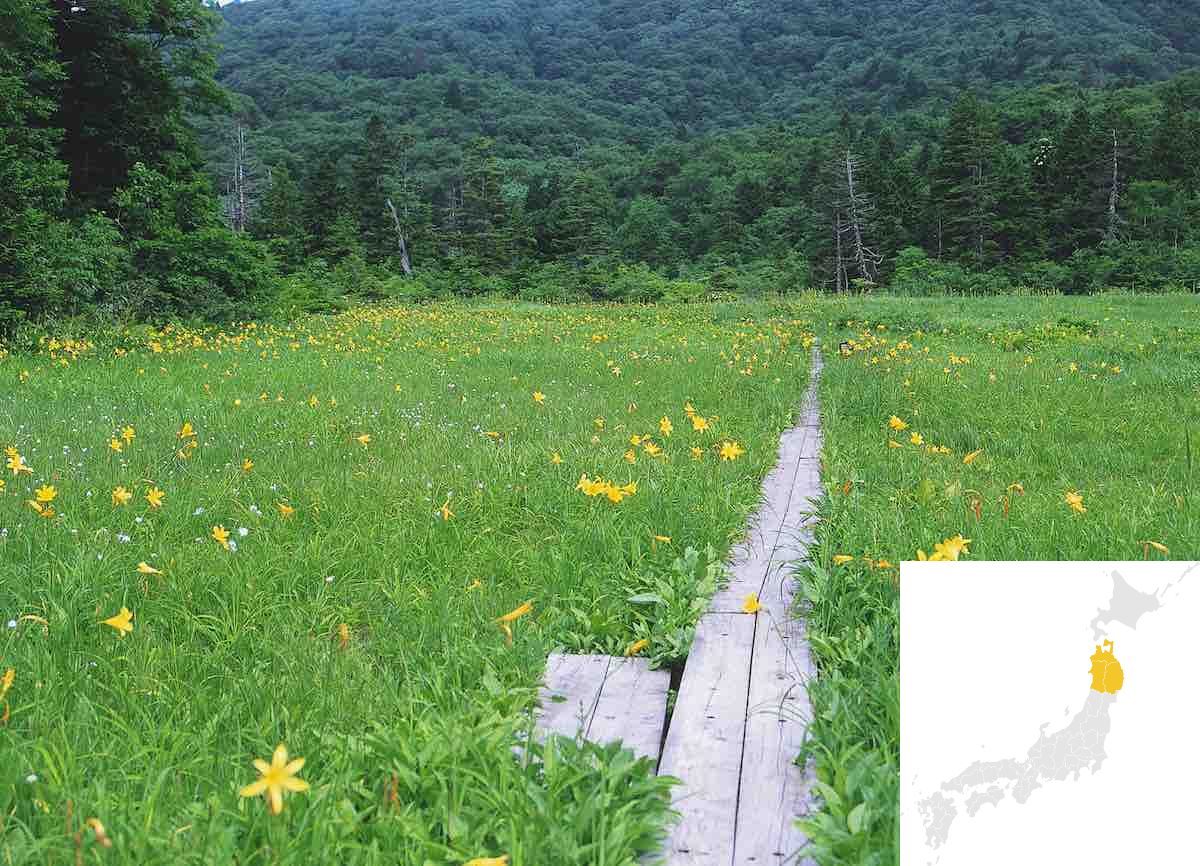
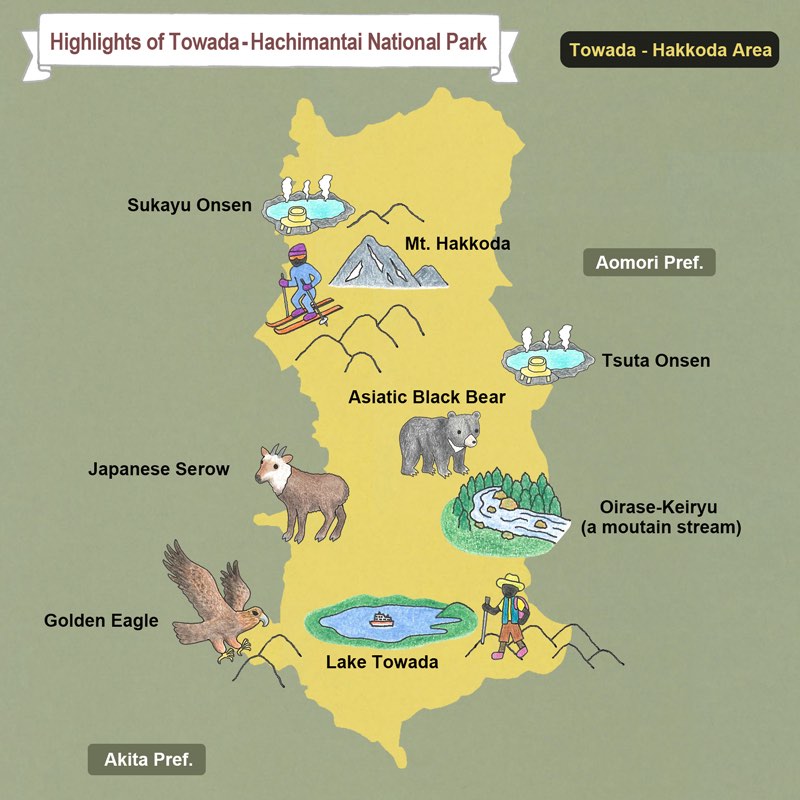
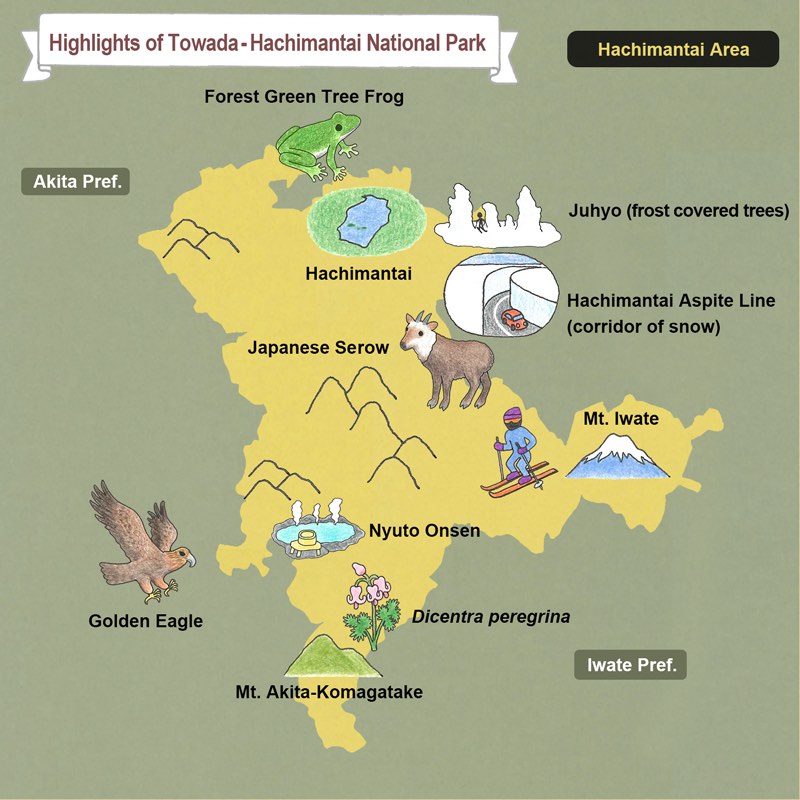
Soothe your body at the land of hot springs and volcanoes
Towada-Hachimantai National Park is nestled in the mountainous belt of the northern portion of Japan's Honshu island. It is an extraordinary national park where you can find mountains, lakes, and streams. A variety of volcanic phenomena can also be observed in the park, such as abrupt changes in the geothermal heat and crust of the earth, resulting in the area also sometimes being called the “Volcano Museum.” The park spans over the two areas of Towada-Hakkoda and Hachimantai. The Hachimantai region has a large number of volcanoes even for Japan, and thanks to this volcanic activity the area is blessed with many hot springs, which is a big part of the park’s attractiveness.
In the Tohoku region of Japan, the word "toji" refers to sojourning at an onsen for an extended period to heal one's mind and body. This area maintains its "onsen culture” even today, and when looking at recorded history, this culture can be traced back 1,300 years. In the past, this culture was enjoyed only by the wealthy, but with the advent of the Edo period, the times became more peaceful and newly built highways allowed the general public to enjoy the onsen as well. Despite the change in era and lifestyle, this culture has been passed down as tradition to the present times.
There are onsen resorts all over the Hachimantai region, each with their own individual quality. You can care for your body and mind at onsen efficacious in healing back pain, sensitivity to cold, sprains, and even mental health. With stone saunas that utilize the heat of the earth and rooms with heated "ondol” flooring, you can experience many unique aspects of this onsen culture.
Towadako Lake, spanning Aomori and Akita prefectures, is a double caldera that was created by vol...
Situated near the summit of Mt. Hachimantai near the border of Akita and Iwate Prefecture, Kagami...
The Hachimantai Mikaeri Pass is a scenic viewing spot on the Hachimantai Aspite Line, a mountain ...
The Oirase Gorge, which runs about 14km from Lake Towada to Yakeyama, is protected as a special s...
Tamagawa Onsen is located inside of Towada-Hachimantai National Park. It's a "touji" inn with a n...
Access
*Depending on the weather conditions, roads may close due to snow, so please check weather and traffic information in advance.
3. Nikko National Park
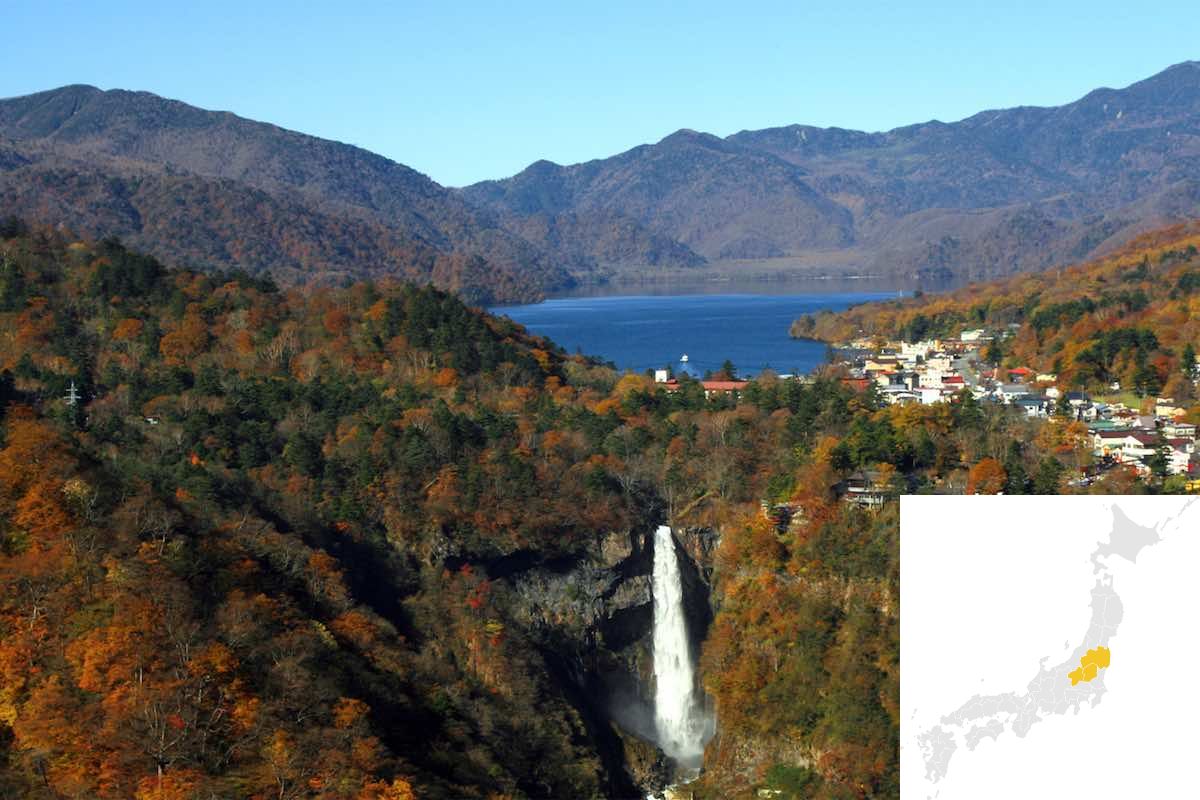
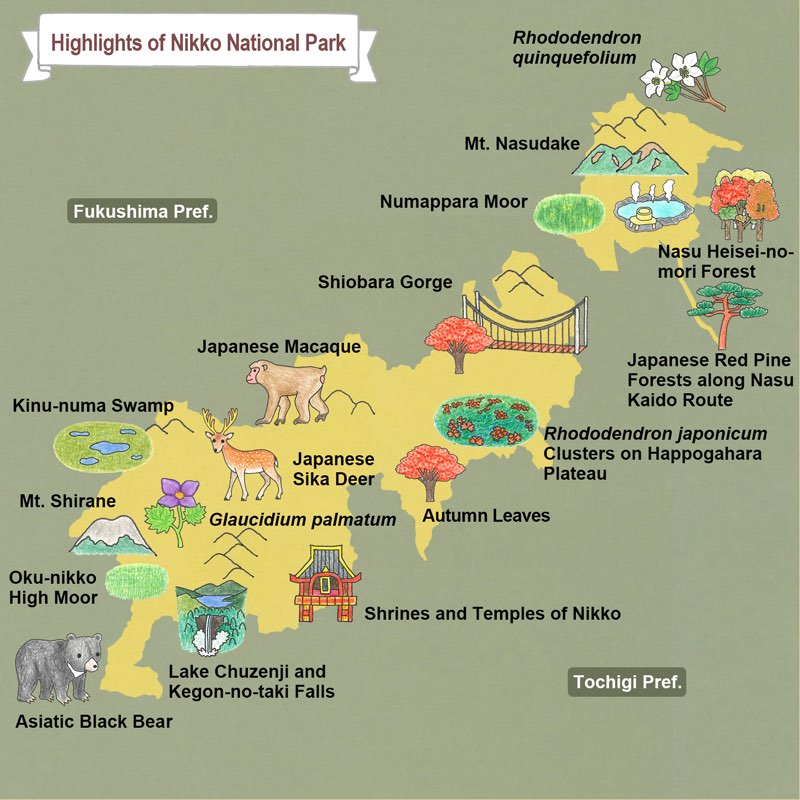
Symbols loved by many people: shrines and temples
Nikko National Park is one of the first national parks of Japan, designated on December 4, 1934, alongside Akan Mashu National Park. Easily accessible from the capital region by train or car, it is immensely popular as a place where one can readily experience both nature and history.
Most of the park's territory is comprised of mountainous highlands. It includes the tallest peak in northern Kanto, Mt. Nikko-Shirane; Mt. Nantai, which has been considered sacred since ancient times; and the volcanically active Mt. Nasu. The land at the feet of these mountains is home to deciduous broad-leaved forests with Japanese beech, mizunara, and maple trees, allowing for beautiful autumn colors.
The park also has various historic structures that remain preserved to this day, including several shrines and temples registered as UNESCO World Heritage Sites: Nikko Tosho-gu Shrine, Futarasan Jinja Shrine, and Rinno-ji Temple among others. Nikko was originally a sacred land for mountain worship that was designated by a monk, Shodo Shonin, who climbed Mt. Futarasan (Mt. Nantai) in the Nara era (AD 710 to 794). Futarasan Jinja Shrine is the founding shrine of the Nikkosan faith. It has attracted believers since ancient times, and Mt. Futarasan itself is worshiped as a go-shintai (where spirits or deities reside). The main enshrined deity of Futarasan Jinja Shrine is Onamuchi-no-Mikoto, the god of good fortune and marriage. Even now, many people pay homage to the shrine to receive blessings for marriage. Furthermore, Tokugawa Ieyasu, the founder of the Tokugawa shogunate samurai government of the Edo era, is worshiped at the Nikko Tosho-gu Shrine. It was made by skilled craftsmen from all over Japan and is decorated with intricate carvings on its pillars. It is a beautiful building featuring brilliant colors, and it is one of the most famous tourist attractions in the area. This national park is unique in the way it blends cultural and historical sites with nature.
Nikko Toshogu Shrine is a famous Shrine located in the Nikko City of Tochigi Prefecture, which ca...
Futarasan Jinja Shrine is an ancient Shinto shrine in Nikko that was erected together with Rinnoj...
Shiobarakeikoku Yuhodo is a walking path in Nikko National Park that stretches for 12km along the...
Happogahara is a plateau in Nikko National Park with an elevation between 1,000 and 1,200m. The p...
4. Iseshima National Park
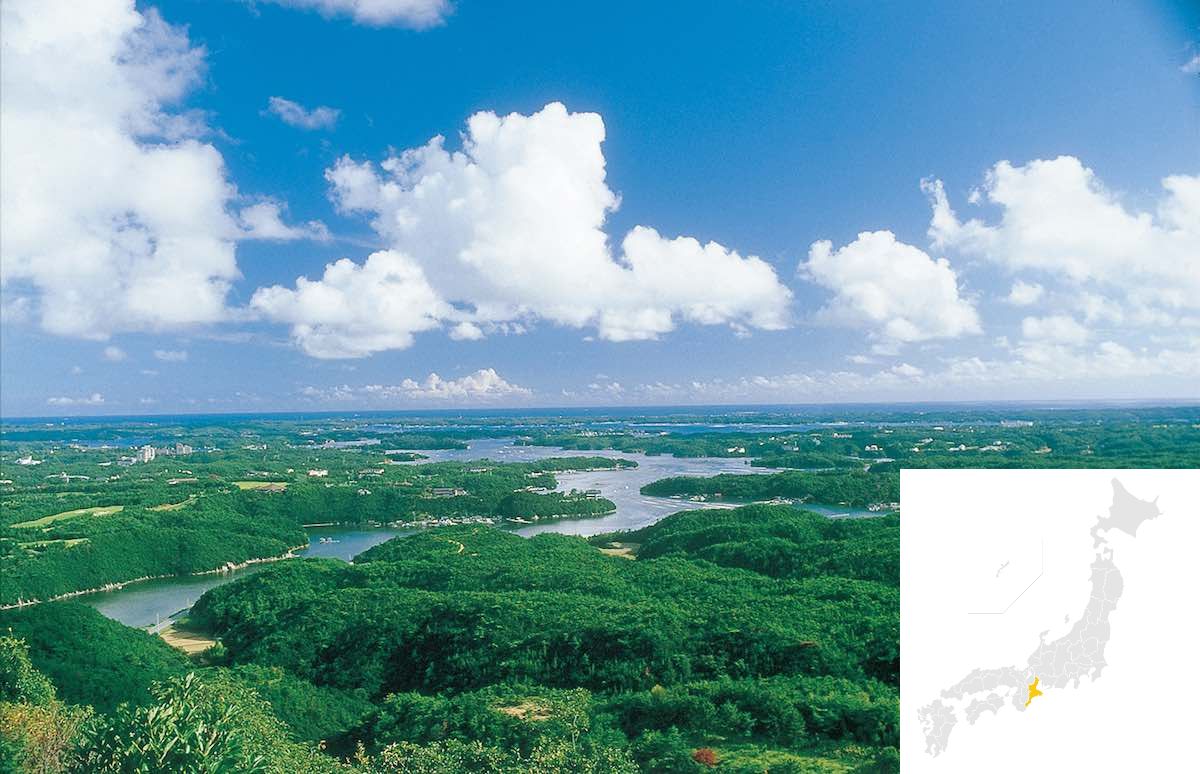
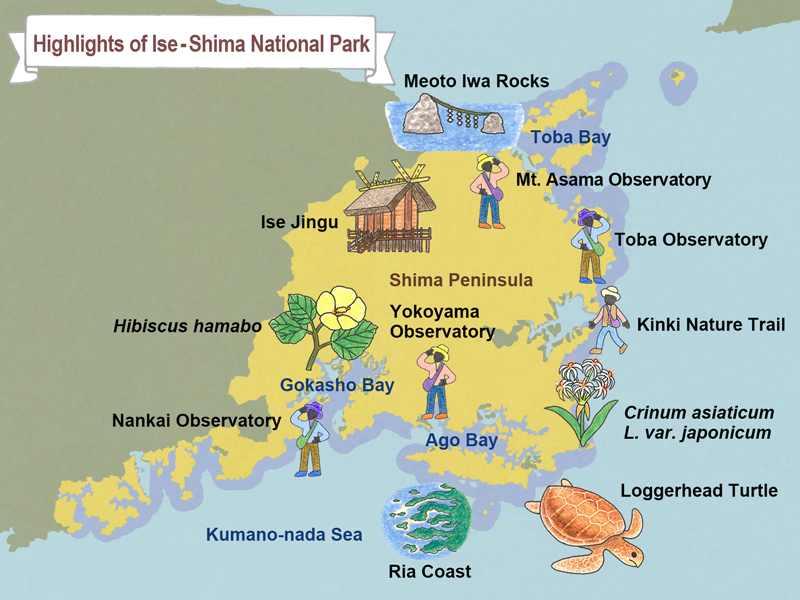
Watched over by Ise Jingu Shrine: a place where history, nature, and people live together
Ise-Shima was designated as the first national park of the post-war era in 1946. It is also famous for hosting the G7 2016 Ise-Shima Summit. It it made up of two large areas: one is inland, centered on a forested environment and home to the Ise Jingu Shrine, said to have a history of over 2,000 years; the other is coastal, most renowned for its ria coast. Compared to other national parks, it has an unusually high percentage of privately owned land at 96%, and it also has many residences. As such, it allows visitors to immerse themselves in the culture, history, lifestyles, and customs of the region.
Ise Jingu Shrine, the icon of Ise-Shima National Park, is often lovingly called "Oise-san" and is an integral part of the people's lives. It contains two main shrines, Naiku and Geku. Naiku is dedicated to the worship of Amaterasu-Omikami, likened to the sun itself and is the ancestor of the imperial household. Geku is dedicated to the worship of Toyouke-Omikami, the goddess who offers food to Amaterasu-Omikami and is the guardian deity of industry.
In front of the Ise Jingu Shrine lies the Okage Yokocho, a beautiful 800-meter-long stone-paved street featuring a townscape reminiscent of the Edo to Meiji period (AD 1603 – 1912) with buildings that were relocated and reconstructed. The street has many souvenir shops and restaurants that you can only find at Ise-Shima. It gets its name after the "okage mairi," a mass pilgrimage to the Ise Jingu Shrine during the Edo period (AD 1603 – 1868). People would come on foot to pay homage, and it would 15 days from Tokyo, 5 days from Osaka, and 3 days from Nagoya. The park is still able to preserve its rich history and culture because it is loved so by the people of Japan.
On the other hand, the area along the seaside includes a complex ria coast. The beach from Kouka to Azena is a breeding ground for loggerhead turtles, and the Meoto Iwa Rocks are said to be a symbol of marriage. The Meoto Iwa Rocks are a group of sacred rocks located about 700 meters offshore that call worship to Okitama Jinseki. A torii gate pays reverence to Okitama Jinseki and the rising sun; from May through July, the rising sun can be seen from between the Meoto Iwa Rocks.
Renowned to be considered the spiritual home of the Japanese and the national religion of Shinto,...
Meoto Iwa, is a spot located in the ocean just off of Saruta Hiko Jinja Shrine in Mie prefecture...
One of the most famous viewpoints in western Japan, the Yokoyama Observation Deck lies atop Mt. Y...
5. Daisen Oki National Park
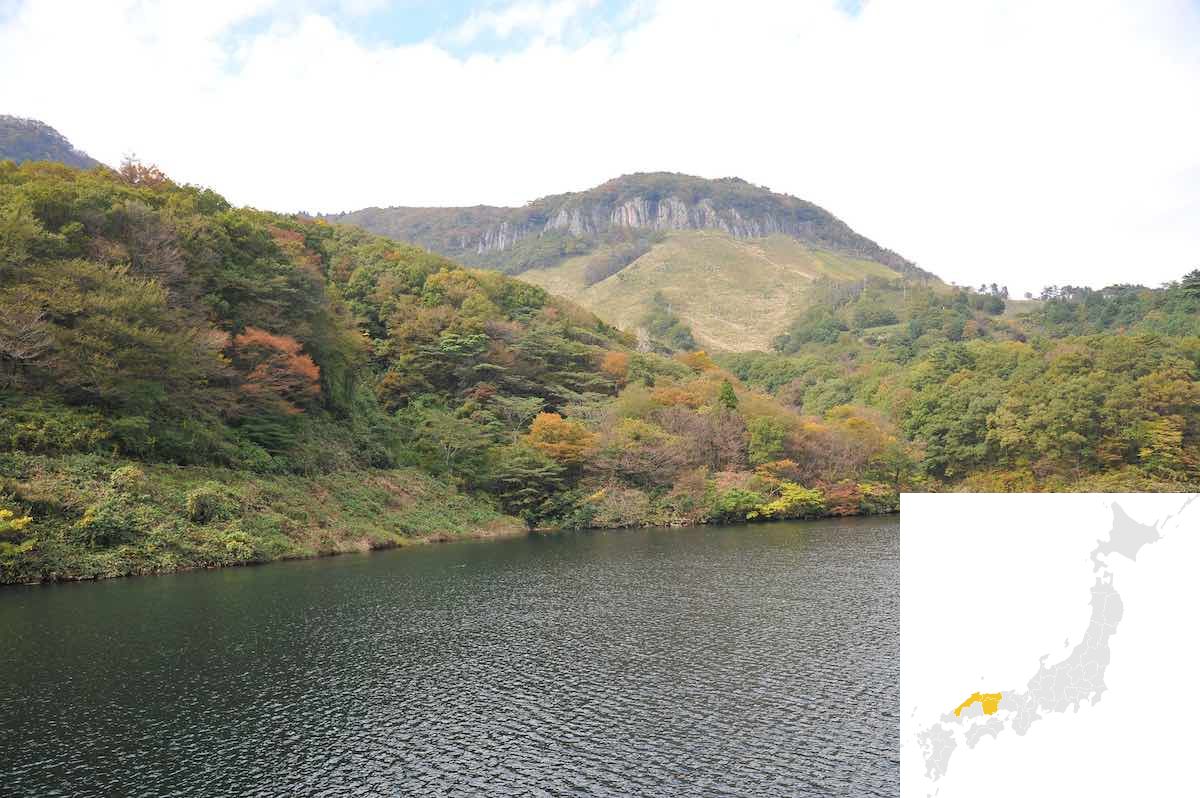
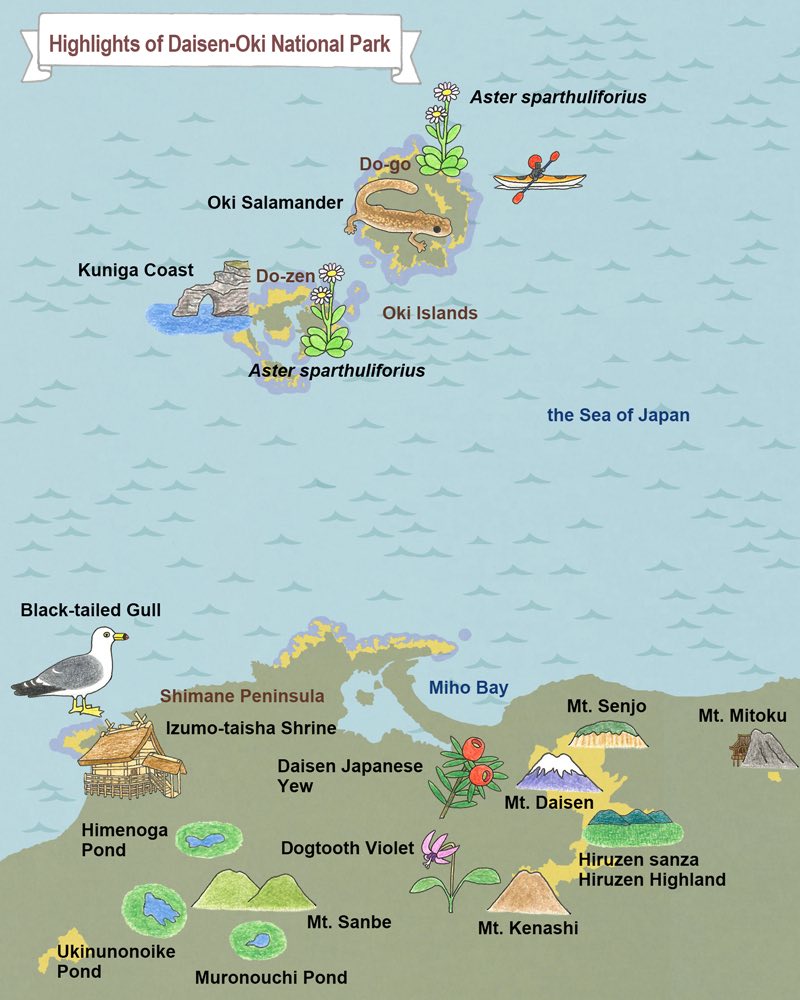
Tie a love knot at Izumo-Taisha Shrine, where deities gather once a year
Daisen-Oki National Park has a rich variety of sceneries and is comprised of four regions: the mountainous region of Mt. Daisen, the Shimane Peninsula coastal region, the Mt. Sanbe region, and the Oki Islands. Here, you can find plants and animals that have adapted to their environment, ranging from lush forests to magnificent volcanic terrain, vast grasslands, unique mountain ranges, and peculiar erosion features created by the waves at the coast. Paired with places like the Izumo-Taisha Shrine, a stage to many of Japan's legends, the park allows you to witness Japanese traditions that are unique to Izumo. It is said that the deity of Izumo, Yatsuka Mizuomitsununo Mikoto, felt that "the land of Izumo is small, so I want to make it larger," and subsequently severed the land on the other side of the sea, put a rope on it, pulled it, and sewed it to the mainland. Thus, the Shimane Peninsula was born. It is said that there are netted stumps on Mt. Sanbe and Mt. Daisen so that the peninsula doesn't get swept away, and that the ropes that fasten it are the Yumigahama Peninsula in Tottori prefecture to the east and Inasanohama beach to the west.
The Shimane Peninsula, while full of legends and myths, has actually repeatedly detached from and rejoined the mainland due to earthquakes and sediments swept in by rivers. In fact, the land is said to have been a completely separate island about 10,000 years ago. A variety of unique features can be seen due to this process, such as towering cliff faces formed by erosion from the waves, rock formations in the shapes of candles, caves, and more.
The Izumo-Taisha Shrine is among the most famous of the tourist spots at this national park. It is said that gods from all over Japan gather at the shrine every year in October. These gods are spirits that dwell in mountains, rivers, trees, rocks, and other natural objects, and they are worshipped by local people. It is said that, when the gods gather, they hold a meeting to decide the marriage partners for single men and women who pray to them regularly. It is because of this legend that Izumo-Taisha Shrine is worshiped as a shrine for marriage.
Izumo Taisha Shrine is a Unesco World Heritage shrine and one of the leading shrines in Japan. It...
Hinomisaki Shrine is about 15 minutes away by car from Izumo Taisha Shrine, a shrine where gods f...
This is a beach located about 1 kilometer west of Izumo-taisha, Shimane prefecture. It is known a...
Mt. Daisen is located inside Daisen-Oki National Park in Tottori Prefecture. Each year on the fir...
Yonago Waterbirds Sanctuary is an internationally-famous waterfowl habitat located in Daisen-Oki ...
6. Aso Kuju National Park
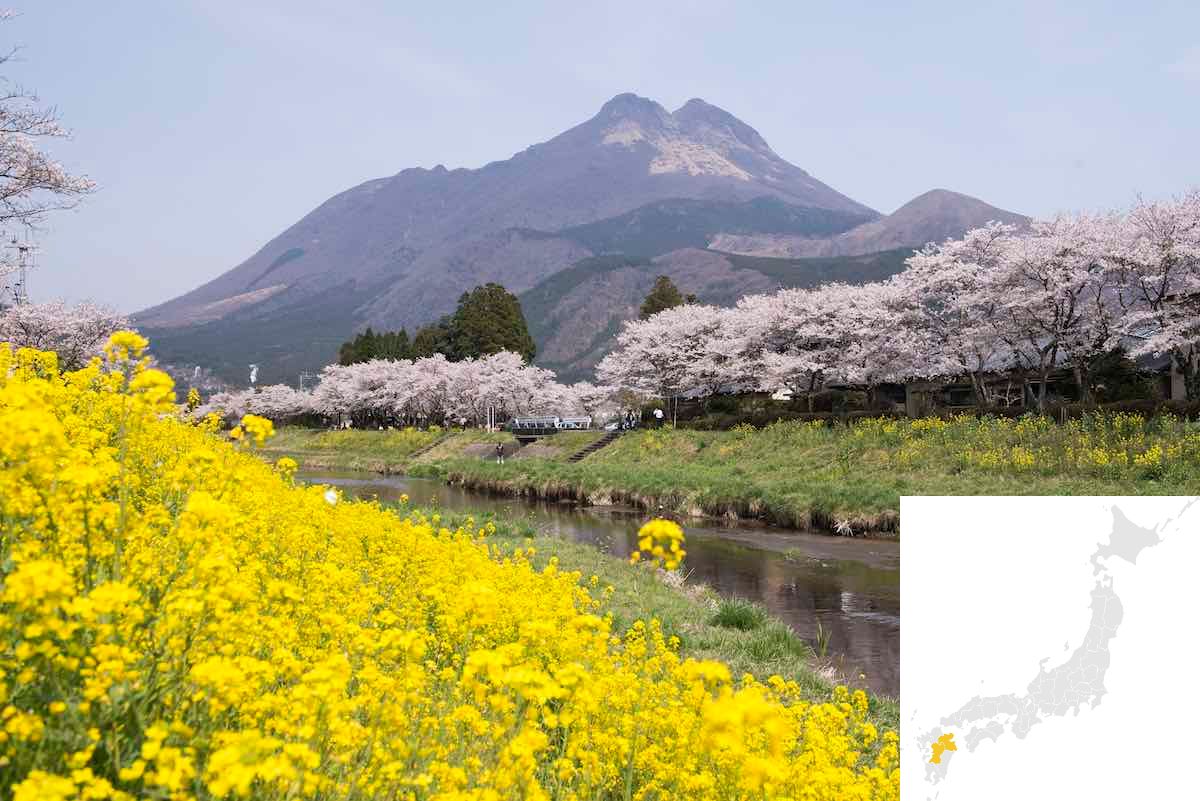
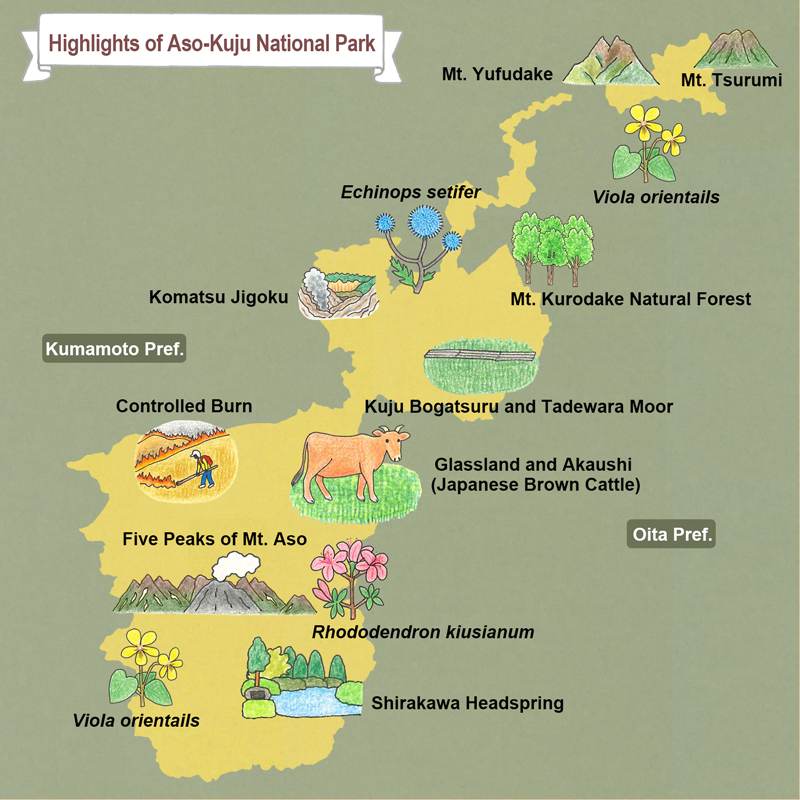
Mt. Aso, one of the world's largest, and grasslands protected by people for over 1,000 years
Aso Kuju National Park is home to Mt. Aso, one of the world's largest active caldera volcanoes. The park also boasts a volcanic range that lies to the north of Mt. Aso as well as a spread of splendid grasslands.
Mt. Aso lies in the southern part of the park, and in its vicinity are a variety of spots one right after the other such as the Nakadake crater, the beautiful conical Komezuka hillcock, and the magnificent Kusasenrigahama grassland. Enshrined in the central region is Mt. Kujurenzan, also known as Kyushu-no-Yane. Due to the hot gasses that rise from within the mountain range, this region also possesses geothermal power plants. The Kujukougen and Iidakougen grasslands as well as the Tadewara and Bogatsuru wetlands allow visitors to enjoy unique environments that are also valuable from an educational perspective. In the northern area of the park there are sites such as Mt. Yufu and Mt. Tsurumi, which are the spring sources of the nationally-famous onsen towns Beppu and Yufuin. Here, visitors will have an wide, unbroken view stretching as far as Beppu Bay, Yufuin Basin, and Mt. Kujurenzan.
At the feet of the mountains, weed-picking and field-burning for pasture grazing has been practiced for many years, and it is still done today. Thanks to these practices that have been performed every spring for over 1,000 years to ensure that the area does not turn into a forest, the beautiful scenery of the grasslands has been preserved. Vegetation in grasslands changes according to how it is used and maintained. Methods such as weed-picking and field-burning protect the growth of unique and valuable plants.
The contrasting scenery between the volcanoes and meadows is just one of the many attractive aspects of this park.
Kikuchi Valley located in the upper stretches of the Kikuchi river, is the source of the river, a...
Umenoki Todoro Koen Park Suspension Bridge is a 116 meter long suspended bridge over a majestic c...
Komatsu Jigoku Hell is located within the Aso Kuju National Park in Oita Prefecture. The place is...
7. Kirishima Kinkowan National Park
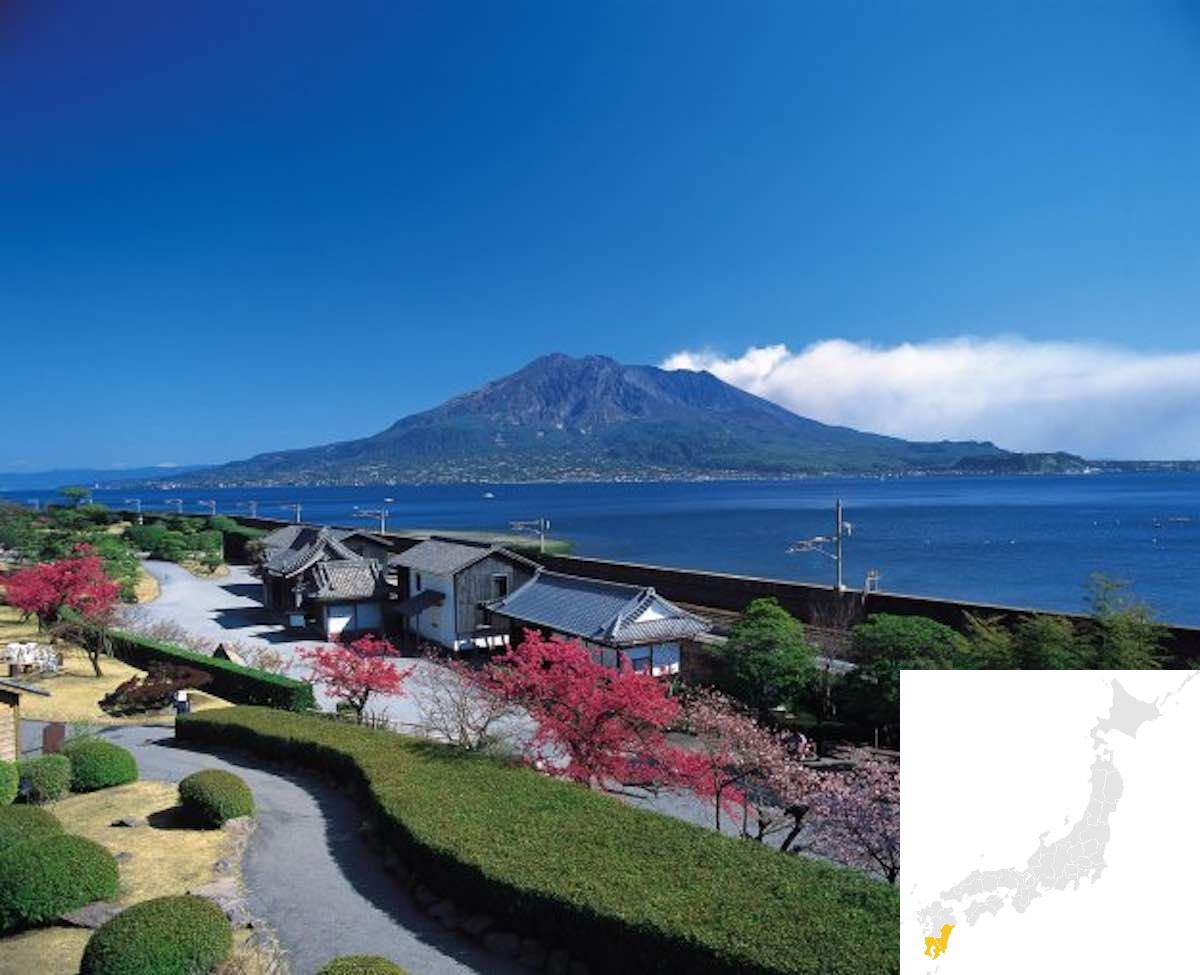
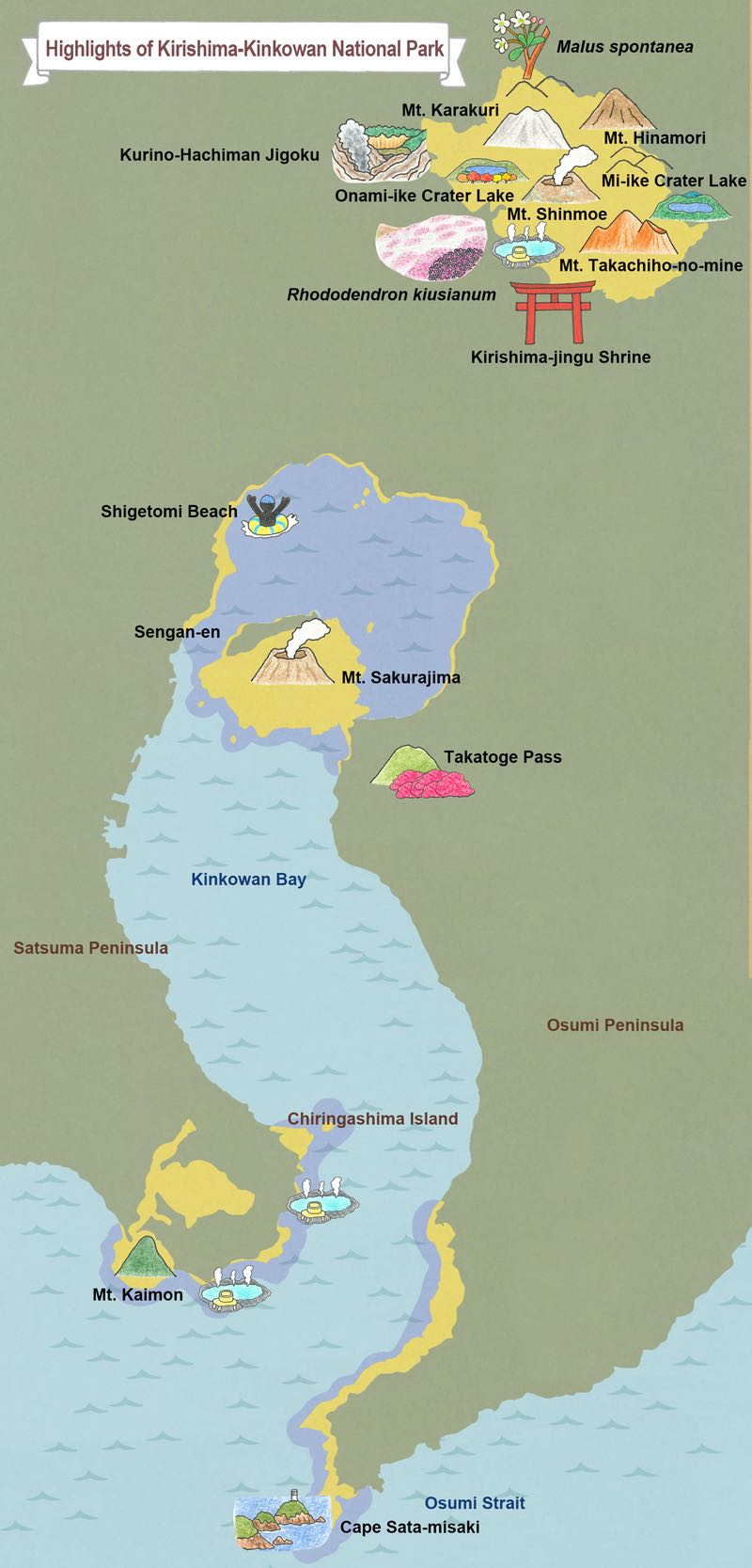
Experience Kyushu's famous sunamushiburo sand saths and renowned landmarks shaped by volcanoes
Kirishima-Kinkowan National Park is another of the first national parks of Japan, designated in 1934 alongside Akan Mashu National Park and Nikko National Park. The park is quite large, comprised of the Kirishima region in the north, which has over 20 volcanoes; Sakurajima Island, known worldwide for its active volcano; and the Kinokowan region in the south, which includes a marine area. At Kirishima-Kinkowan National Park, there are currently active volcanic peaks as well as a number of large-scale calderas formed from past volcanic eruptions. Mt. Kirishima is a group of 20 different volcanoes located in the Kirishima region. It has six crater lakes, and it is known worldwide for its unique geographical features. It is said that the mountains exhibit seven colors during the course of the changing seasons, including the pink of kyushu azalea flowers in spring, the green of fresh verdure in summer, the red and yellow hues of turning leaves in autumn, and the white of rime ice in winter.
Moreover, due to the active volcanoes in the area, the Kirishima-Kinkowan National Park is also famous for its abundance of natural hot springs. The sunamushiburo sand baths in particular are characteristic of Kagoshima. To take a sand bath, a customer will lie face up on a bed of designated sand and have more sand of temperatures between 50 and 55 degrees Celsius poured onto their body by bath workers. The sunamushiburo sand baths have been a favorite among therapeutic bath enthusiasts for over 300 years. The baths are said to be efficacious in relieving neuralgia, rheumatism, lumbago, joint pain, fractures, and many other conditions. They are also said to increase cardiac output and raise the inner temperature of one’s body. By promoting healthy blood circulation, this aids in ridding the body of inflammatory and pain-causing elements while at the same time helping to replenish oxygen. According to a study by the Kagoshima University Faculty of Medicine, the effectiveness of sunamushiburo sand baths were as much as three to four times that of traditional water onsen.
Sengan-en Garden is a Japanese garden that was created in 1658. It is designed so as to skillfull...
A volcanic island in Kagoshima Prefecture, Sakurajima Island is known as the symbol of the prefec...
Sunamushi Kaikan Saraku is a facility where visitors can enjoy both a <i>sento</i> public bath an...
8. Kerama Island National Park
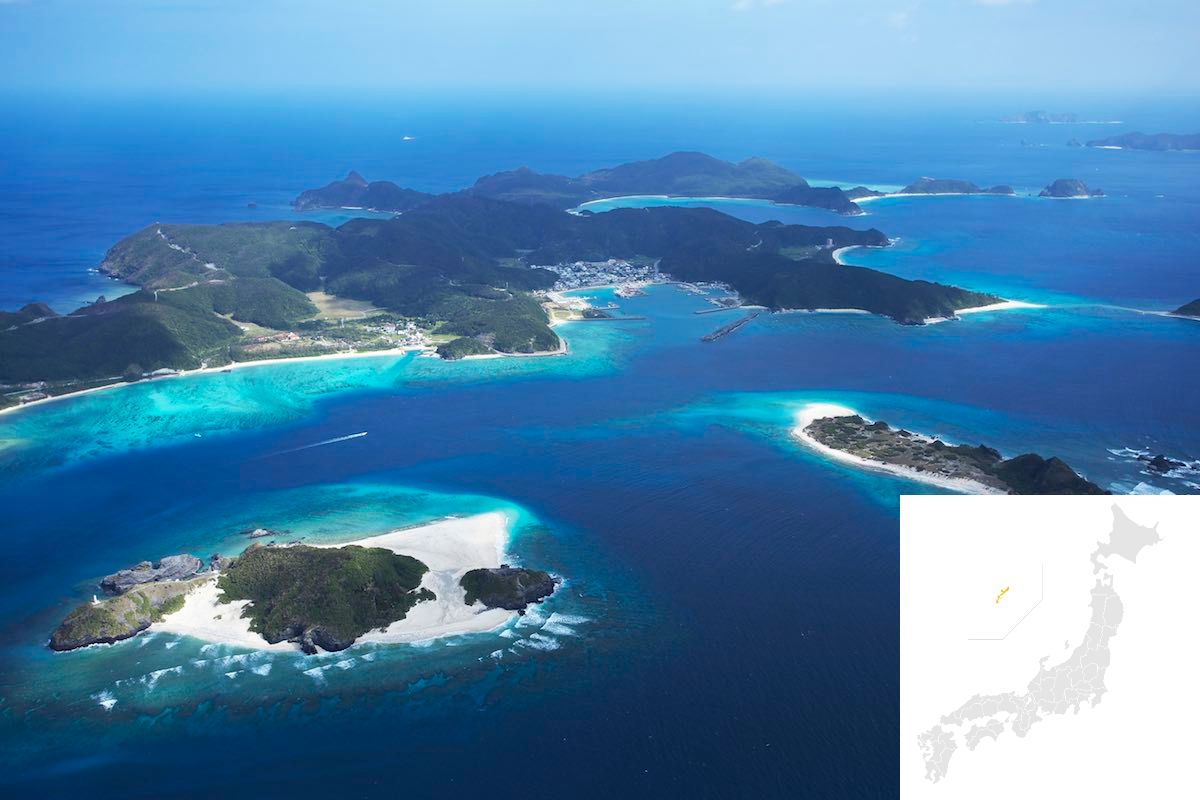
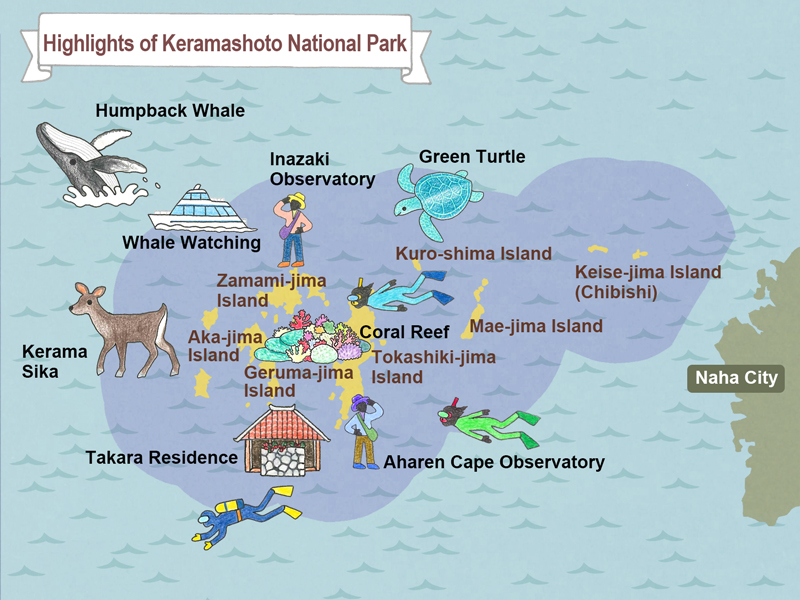
Ocean and islands: the world of Kerama Blue
The Kerama Shoto Islands are a collection of more than 30 islands and a number of reefs. The beautiful transparent water of the ocean surrounding the islands, known as Kerama Blue, is a unique characteristic of the park. Coral reefs packed with life, breeding grounds for humpback whales, archipelago sceneries, coral fragments, beaches white with star sand, sea turtle spawning grounds, and the jagged ria coast with its characteristic wind-swept vegetation can all be enjoyed here. The park can be accessed from Naha city on the main island of Okinawa by high-speed boats, and the trip only takes about 35 to 50 minutes. Diving and snorkeling are popular in summer, while in winter many people opt to participate in whale watching; however, the highlight of the park is the scenery of land and ocean intertwined.
Additionally, the Kerama Shoto Islands are home to a number of important cultural properties of the Okinawan people, such as utaki sacred places, kaizuka shell mounts, and various historic landmarks. The buildings known as takarake dwellings in the villages on Geruma island, located within the Kerama Shoto Islands, are also among such cultural properties. These buildings are said to have been constructed by sailors from official government ships during the 19th century when the Kerama Shoto Islands were acting as a stopover point for sea trade between China and the islands of Okinawa. Each village has its own place of worship, known as uganju, where local people pray to deities for prosperous fishing and safe voyages. Annual festivals and events, such as the Umigami Matsuri and Hama Ori, are also held here. Also, to pray for abundant harvests, the entire community participates in various customs such as tug-of-war with a specially-made rope in the Otsuna-hiki event. With such traditions, events and customs from the past are practiced and protected even in the present.
Nishibama Beach is located on the quiet Hateruma island of Okinawa. It is known internationally f...
Kozamami Beach is the main beach in Zamami Island that received 2 stars in the French Michelin Gr...
Aharen Beach is the main beach of Tokashiki Island, and it boasts 800 meters of smooth, white san...
When visiting national parks, please practice good etiquette!
Please do not litter.
Please do not pick the plants.
Please do not feed the animals.
Please do not catch the animals.
Smoking while walking is prohibited.
Only light bonfires in designated areas.
Please do not stray from the walkways and hiking paths.
Please do not approach wild animals.
For those who want to experience as many spots as possible:
This article introduced eight national parks in Japan and some recommended spots within them, but there are countless other must-see places! We also recommend traveling with a tour guide in order to get around efficiently and gain a deeper knowledge and appreciation of the places you visit. If you’re interested in taking your trip to the next level, please contact us! We will gladly help you find a travel plan best suited for you.
For freedom in your travels, we also recommend renting a car!
National parks are so large that it’s difficult or impossible to experience it all in just one day. For those who would prefer to move about freely without worrying about public transportation facilities, please see here.
Sponsored Links
Unmissable Tours
Expand your horizons by interacting with diversity. Take a look at guided tours on which you can connect personally with the guides and have truly extraordinary experiences.
Search
